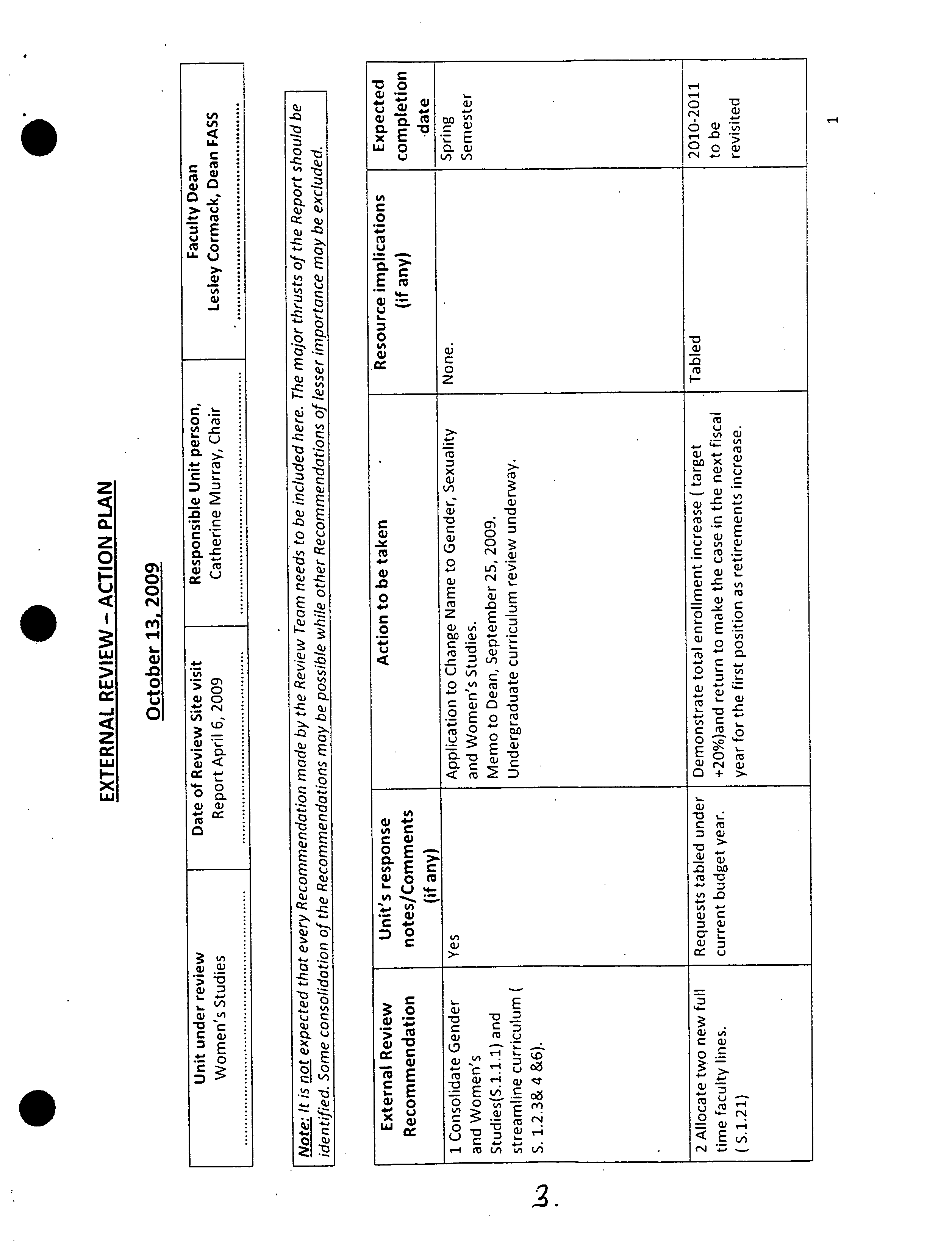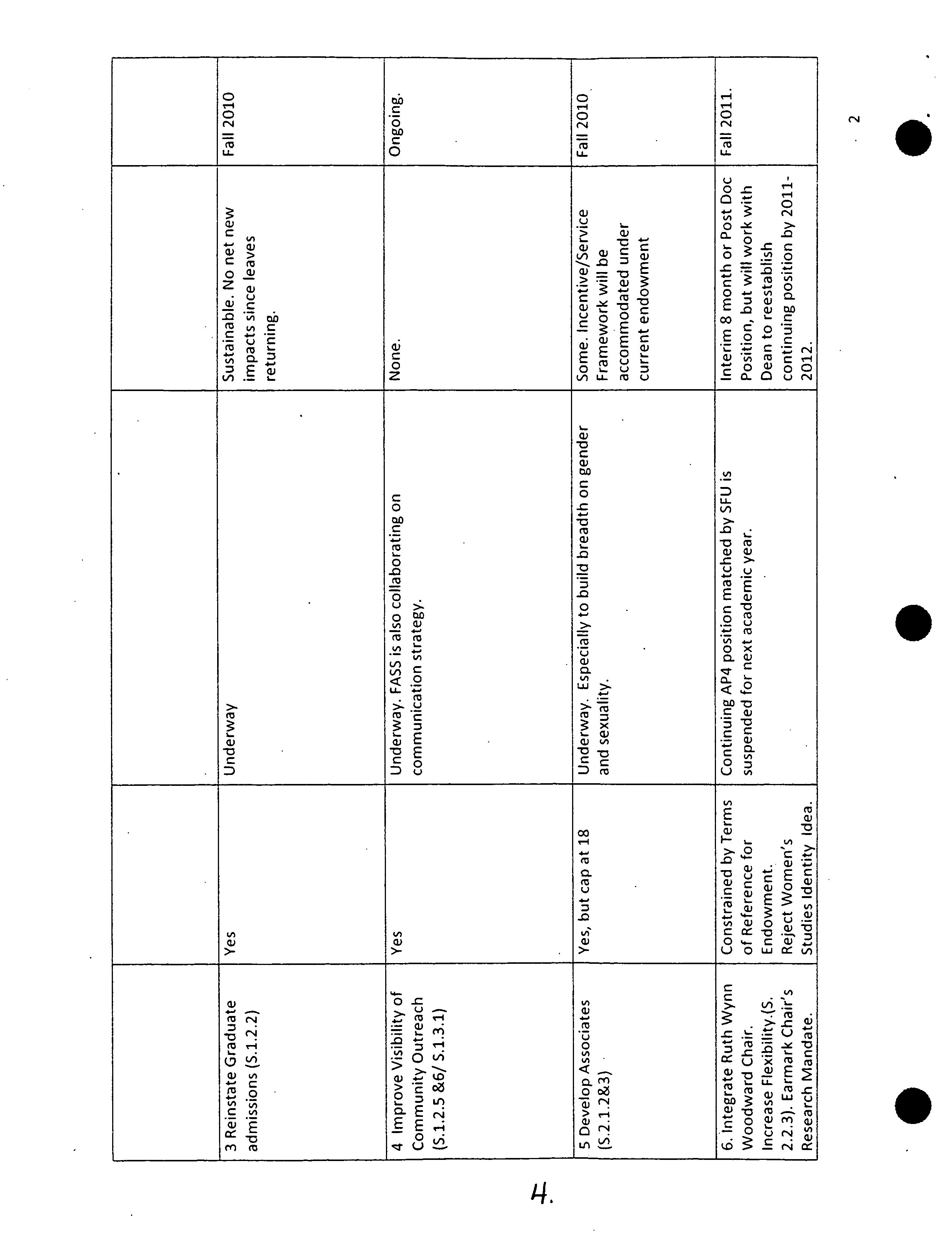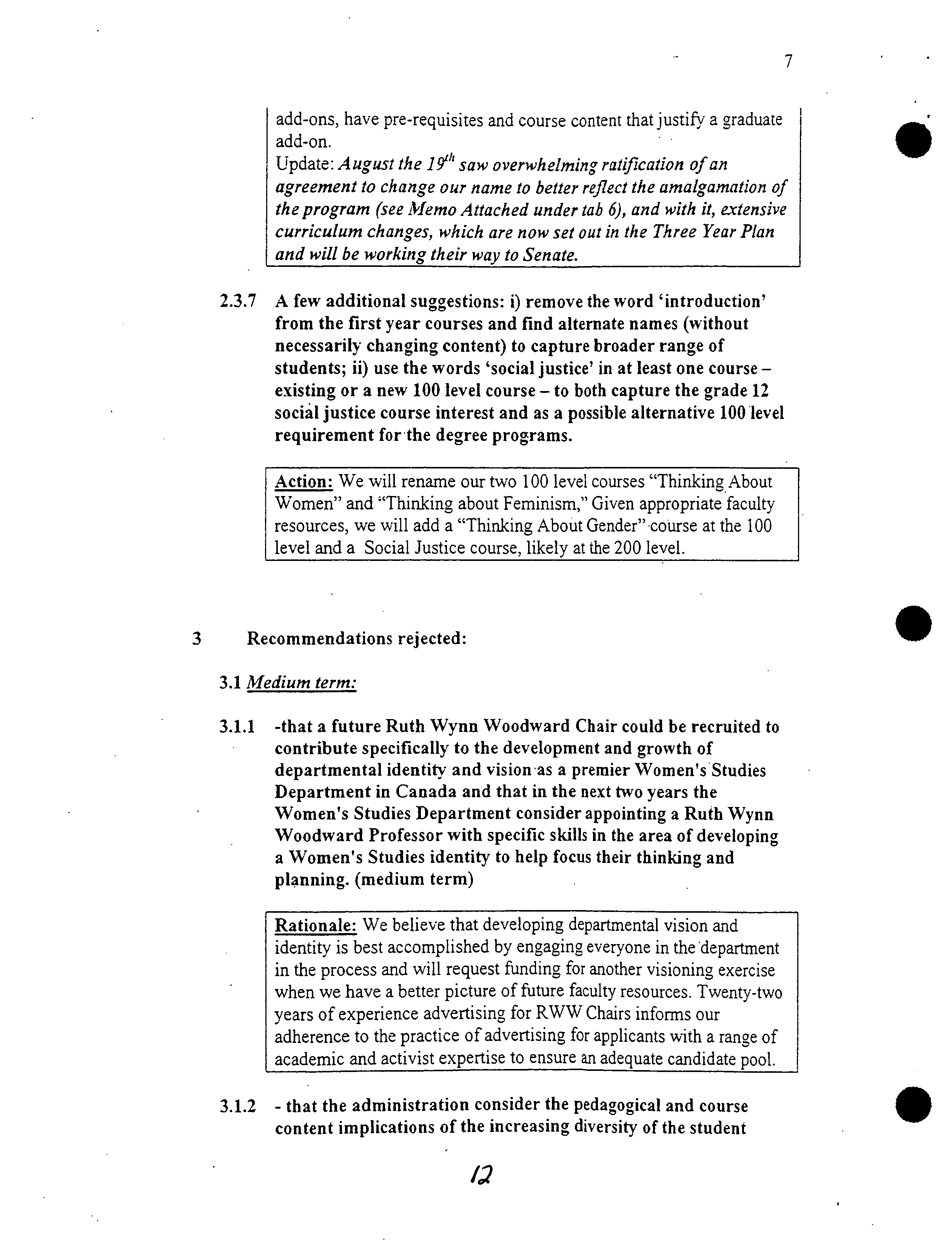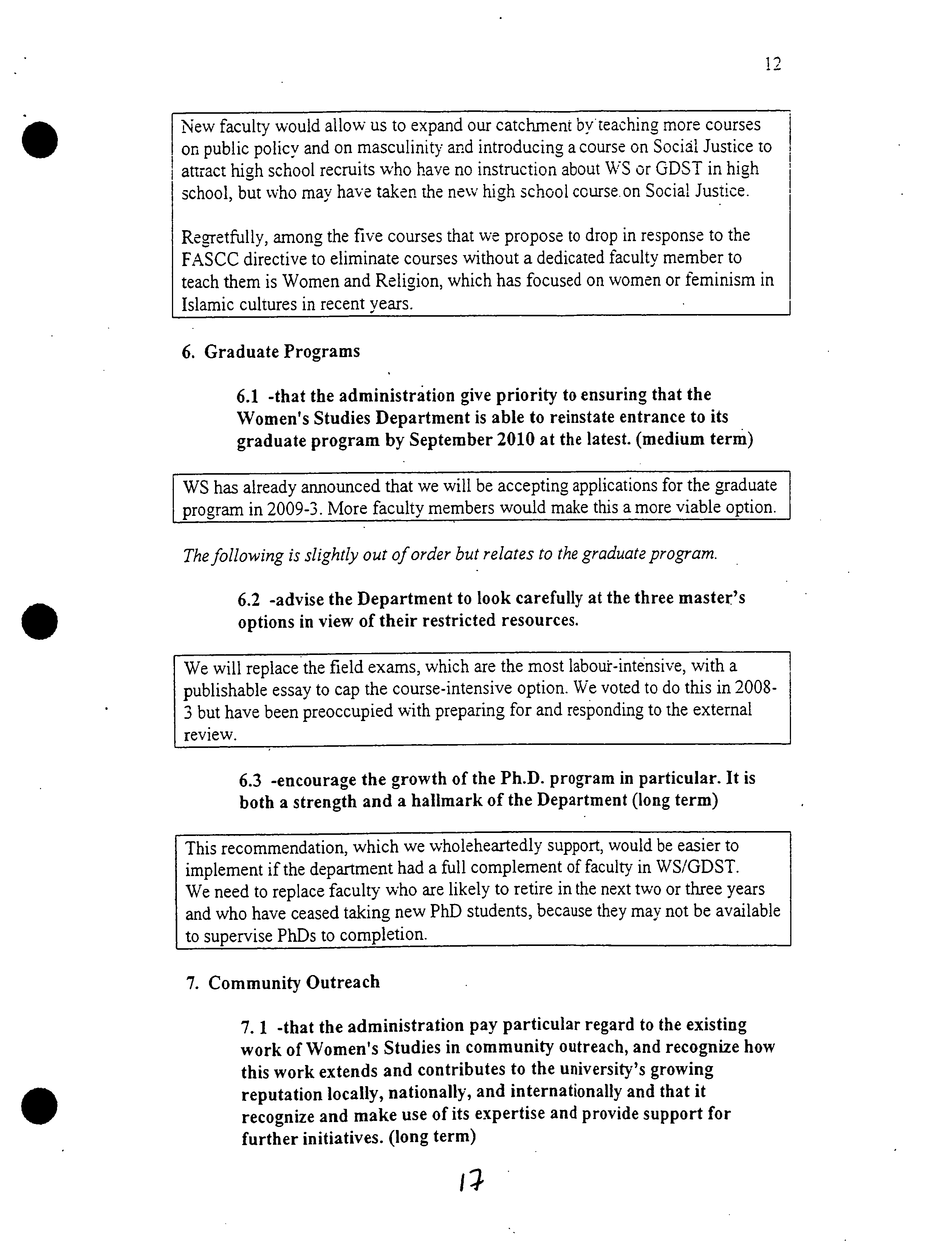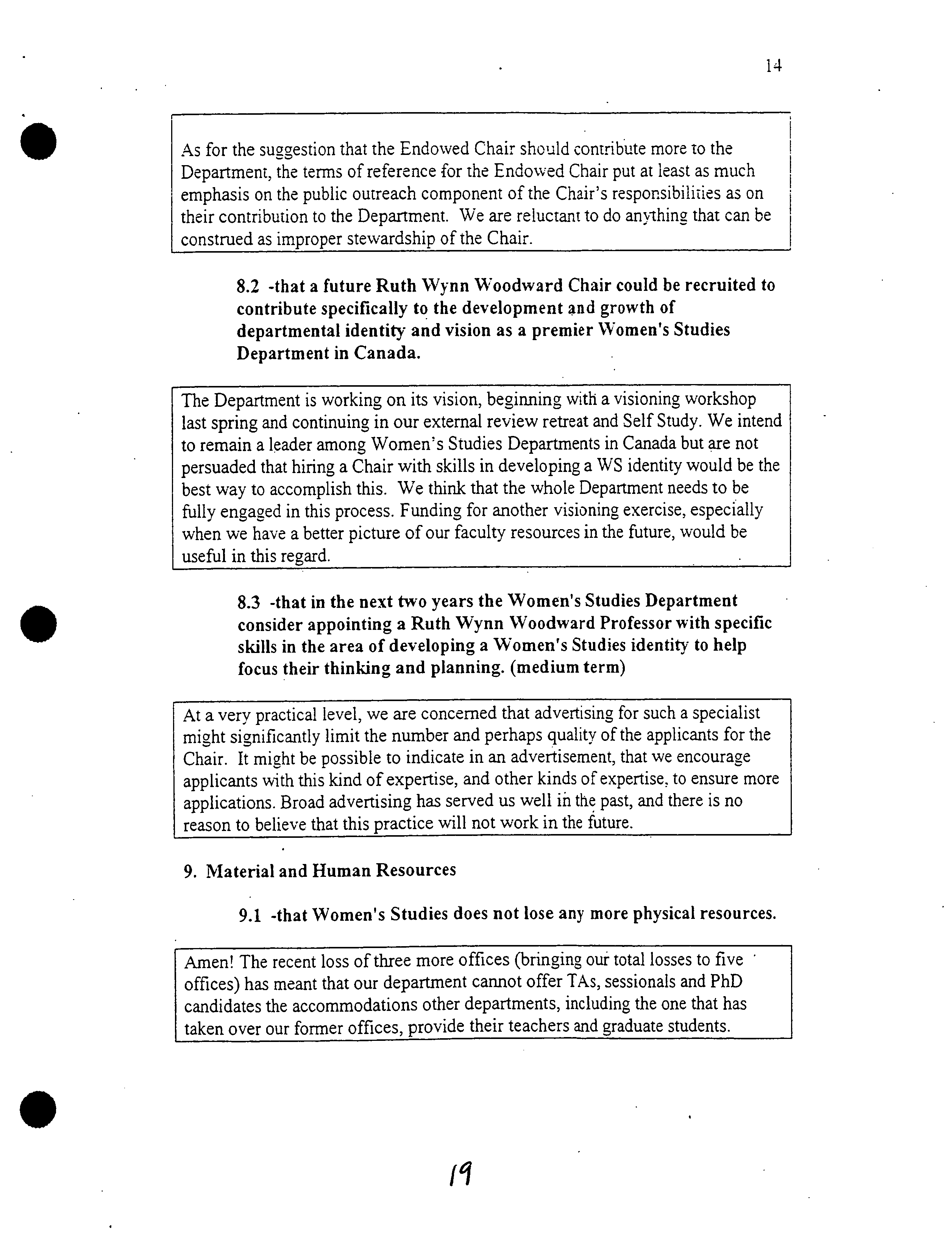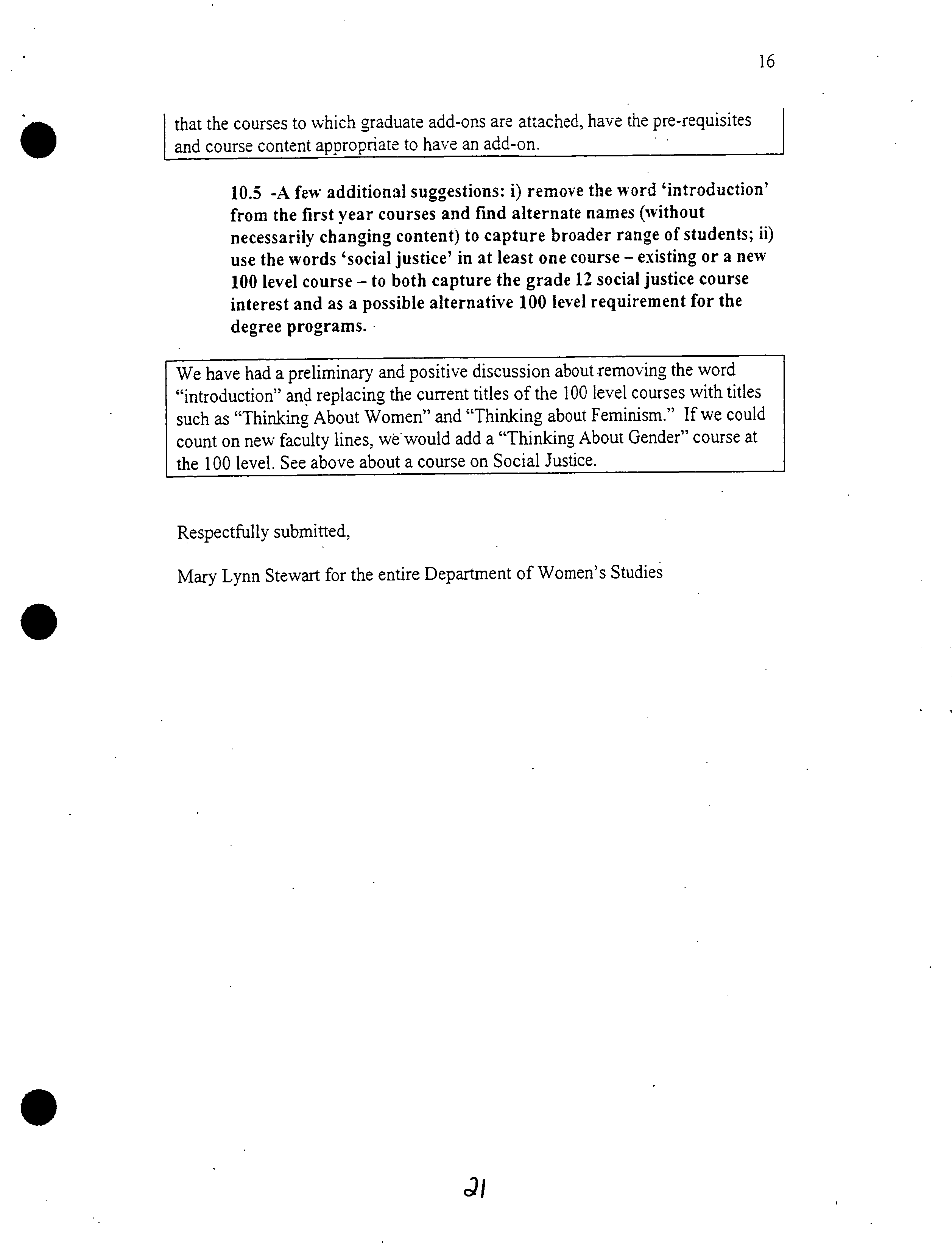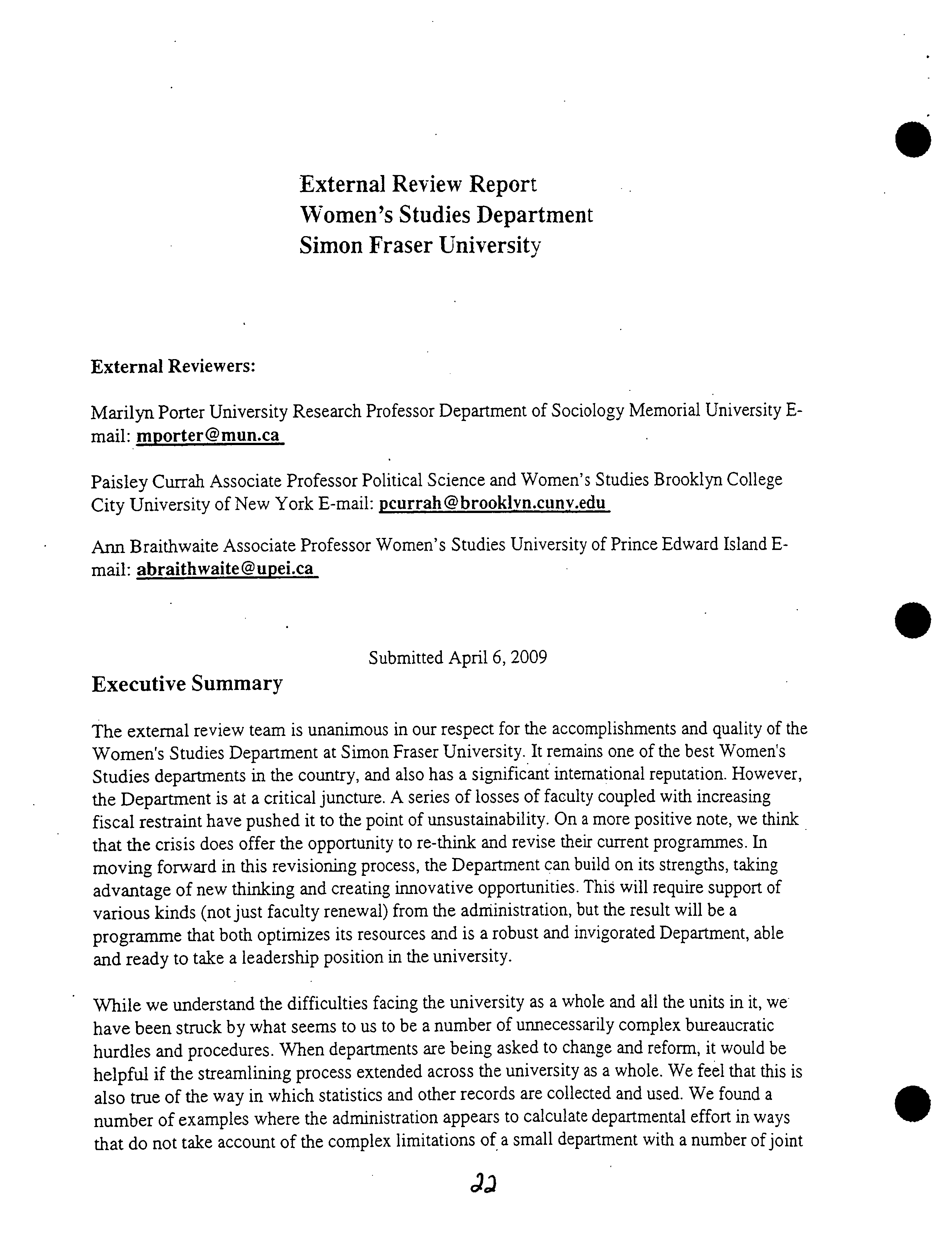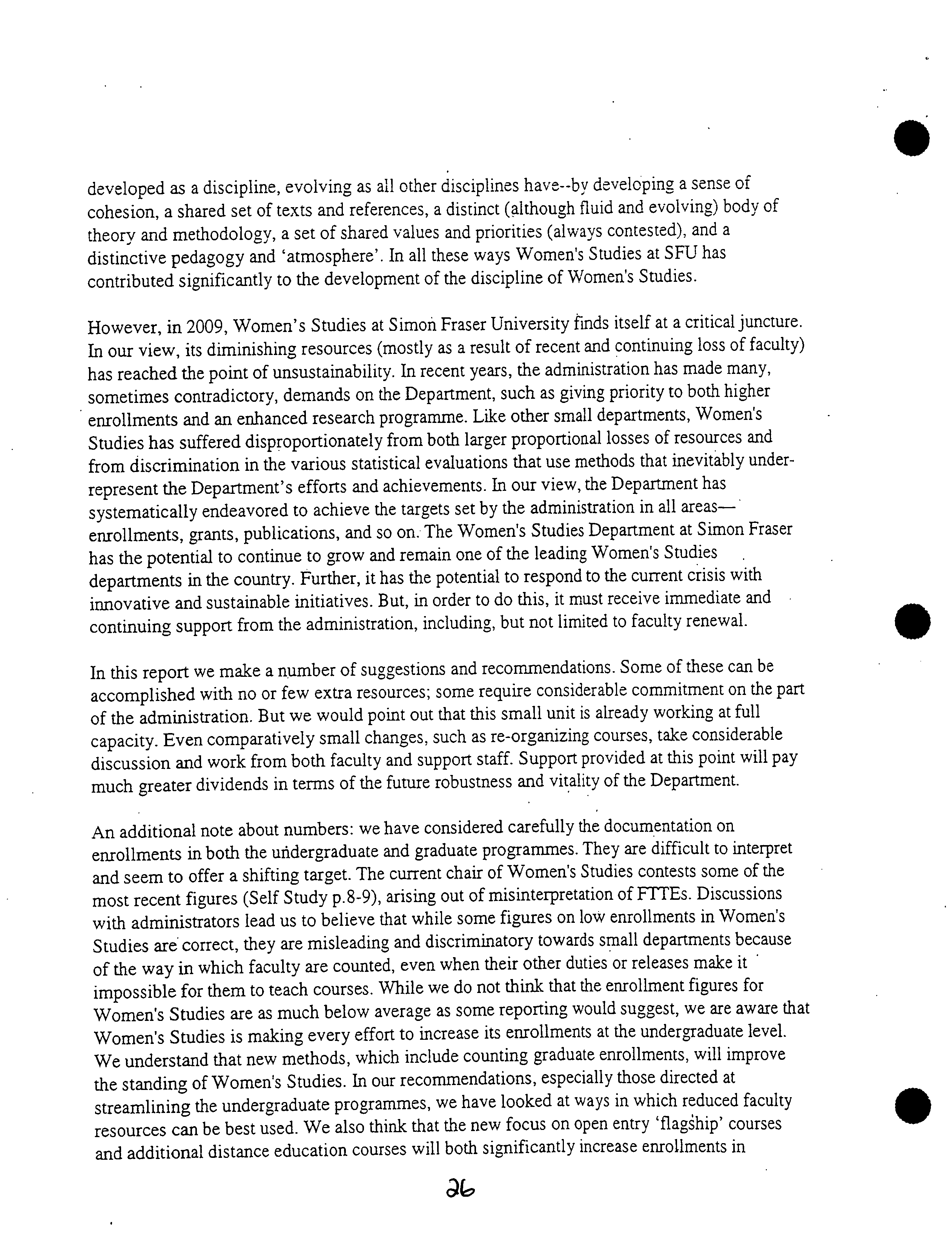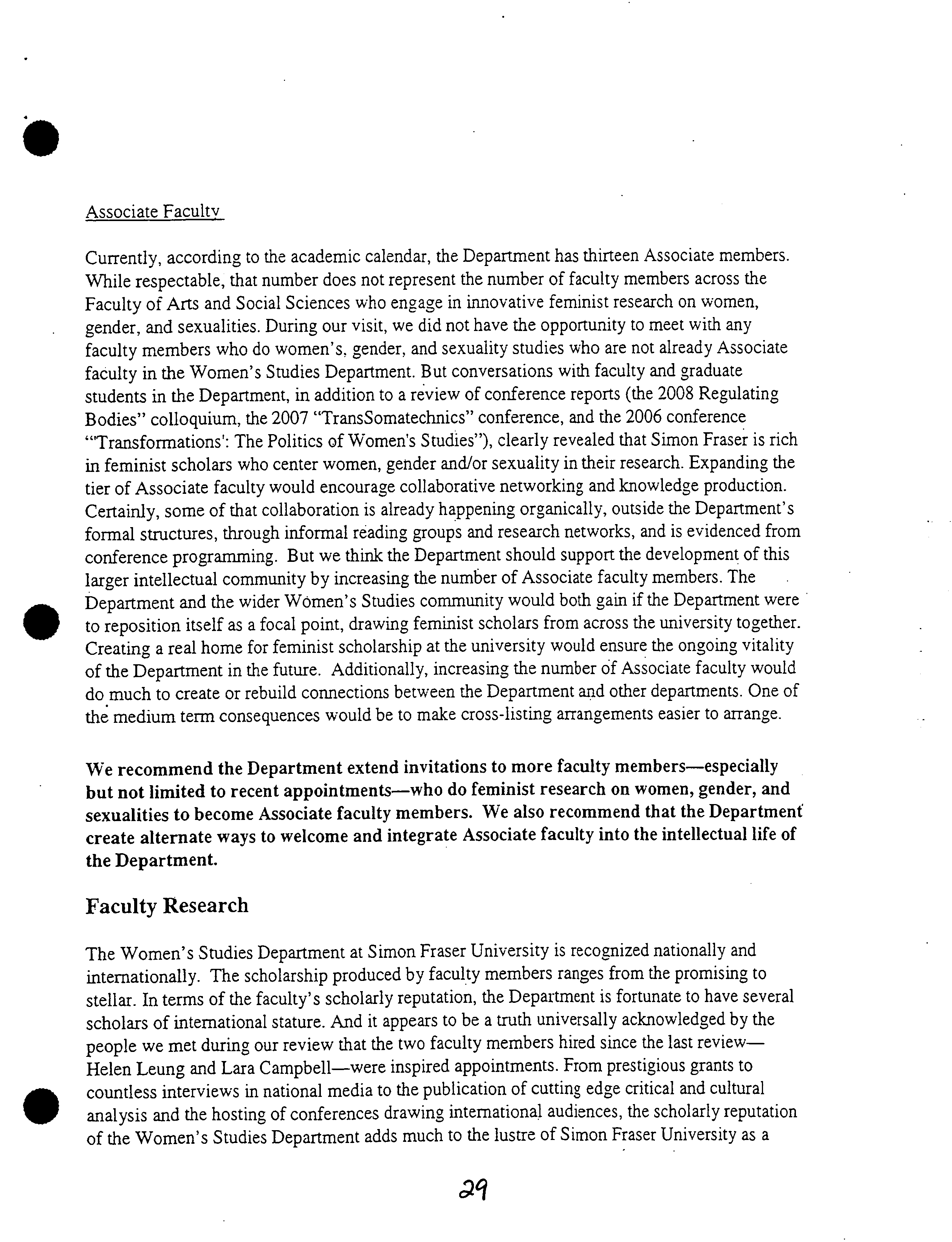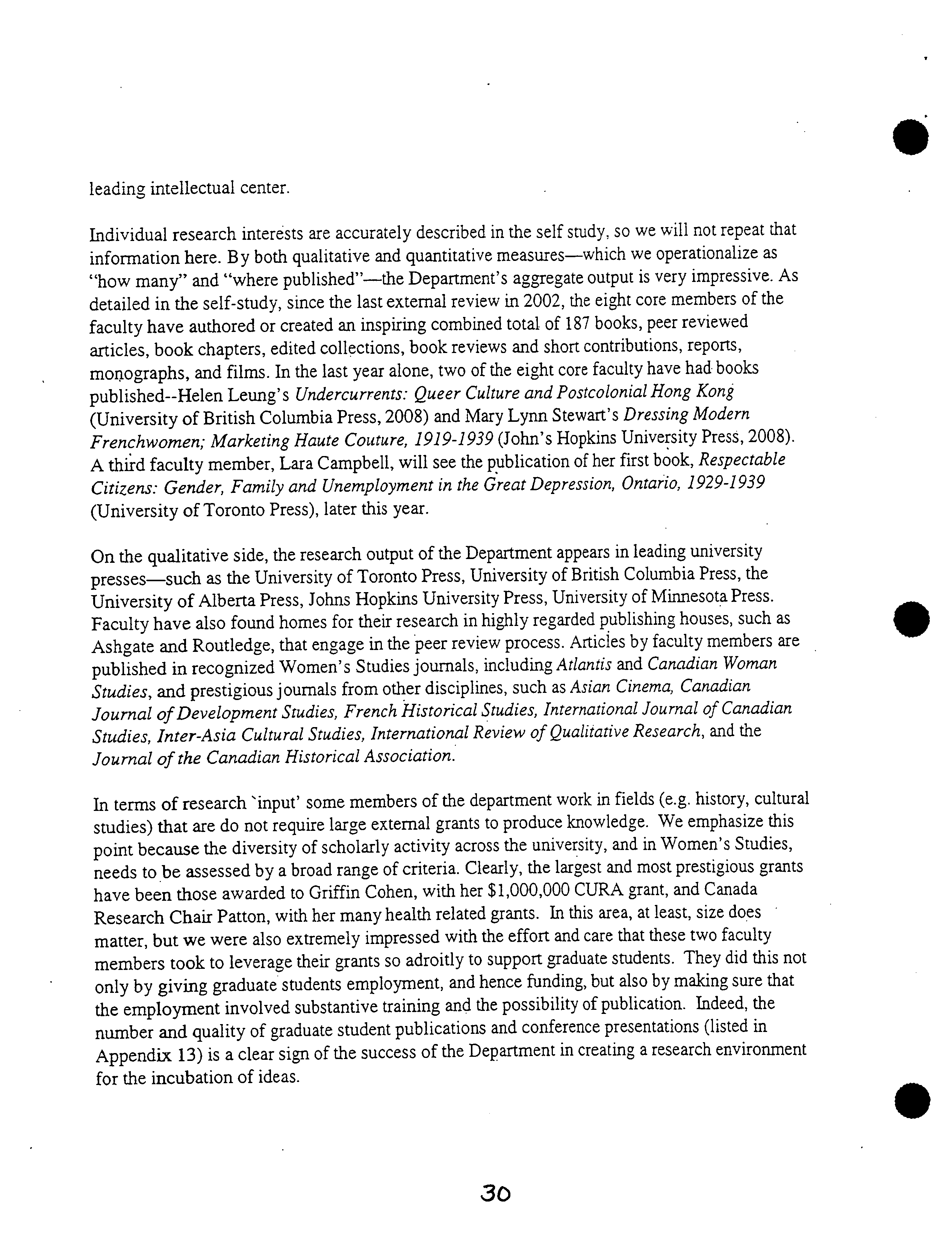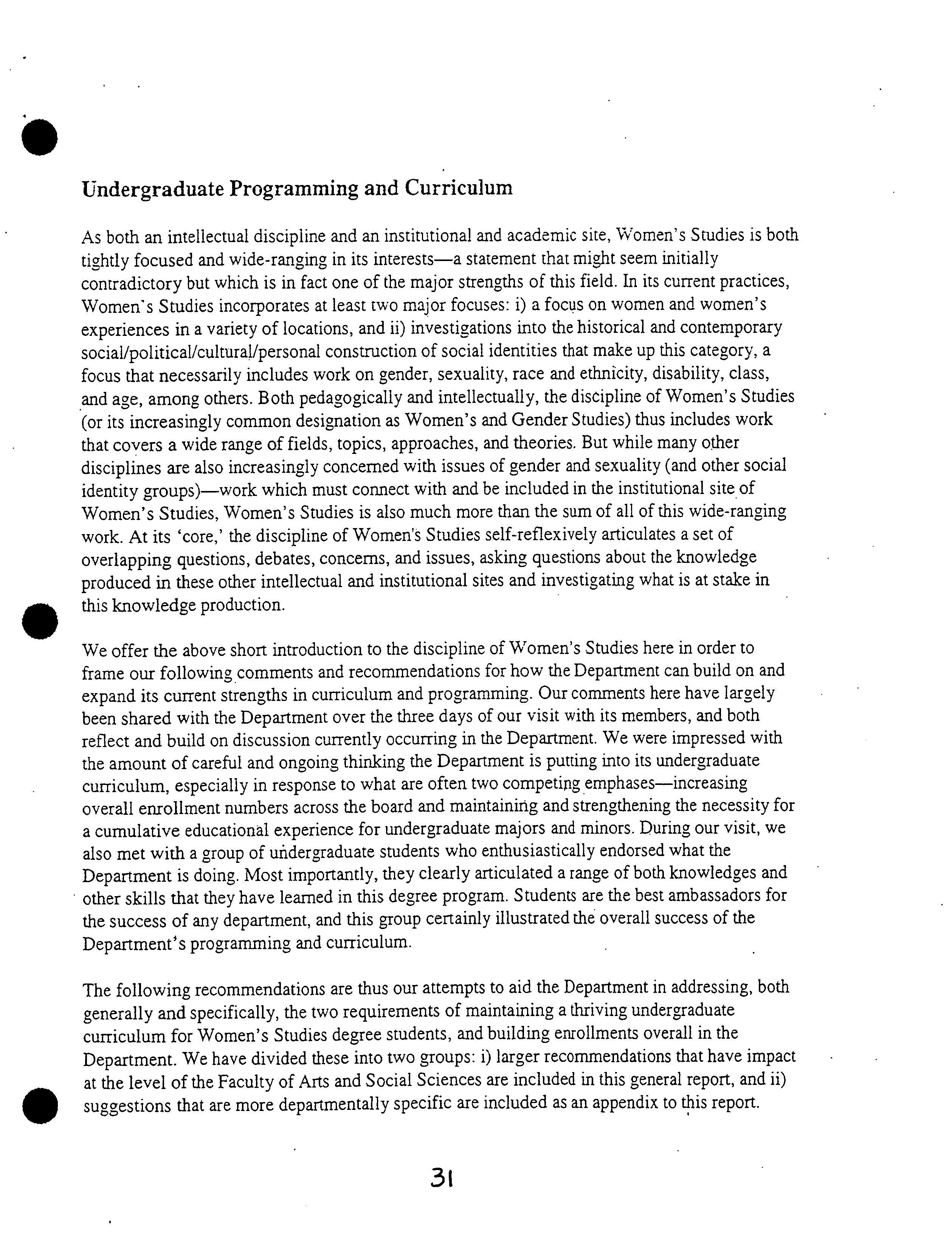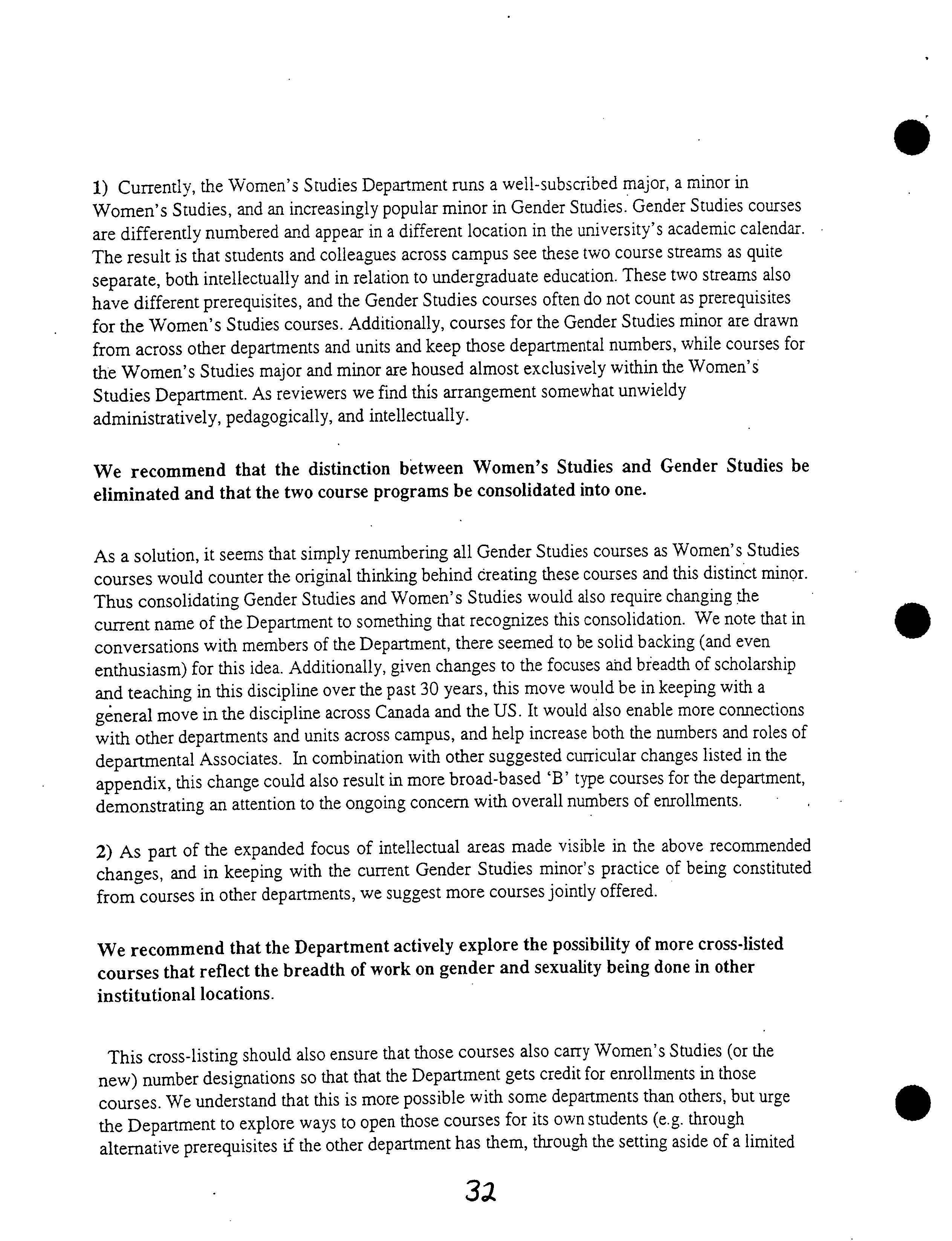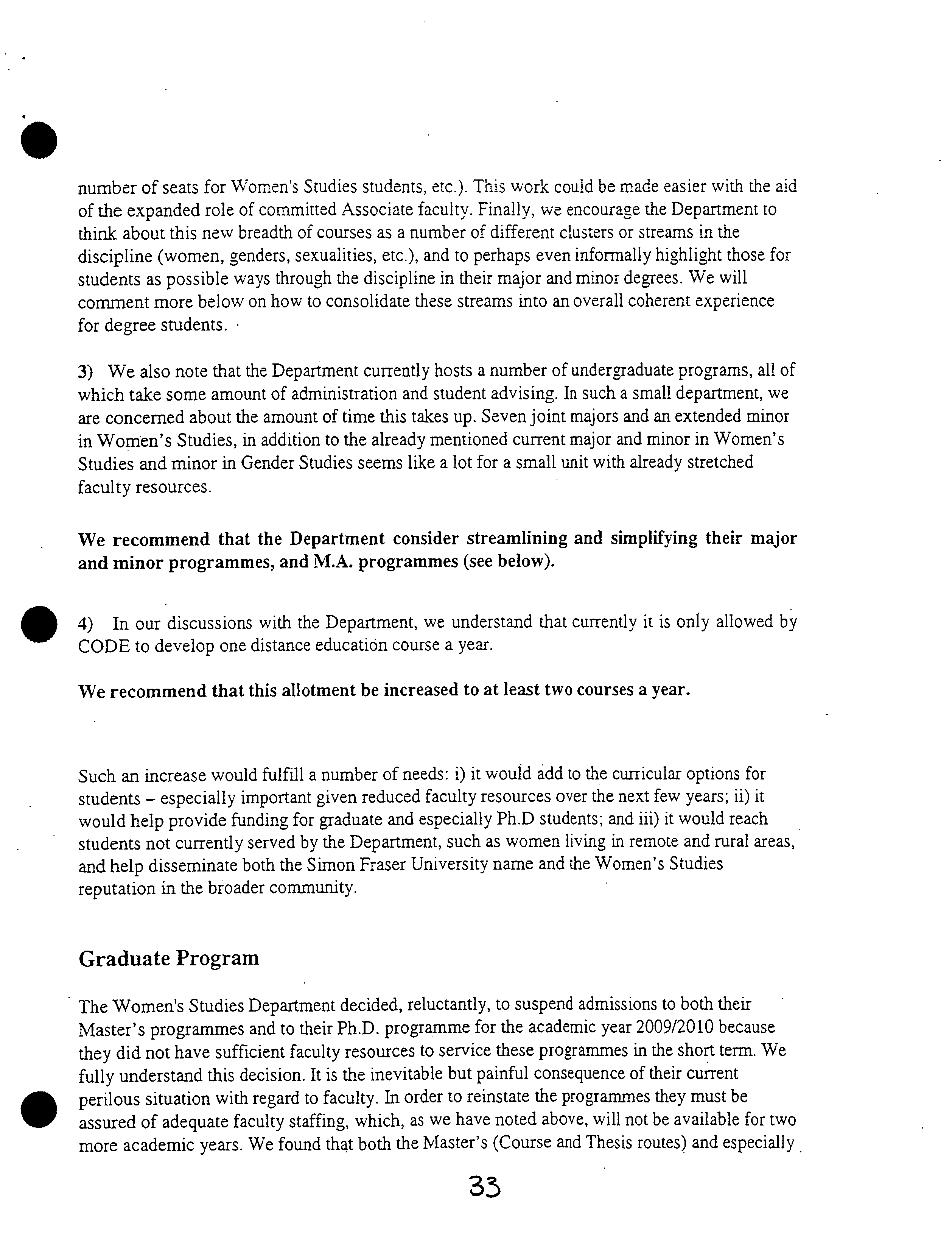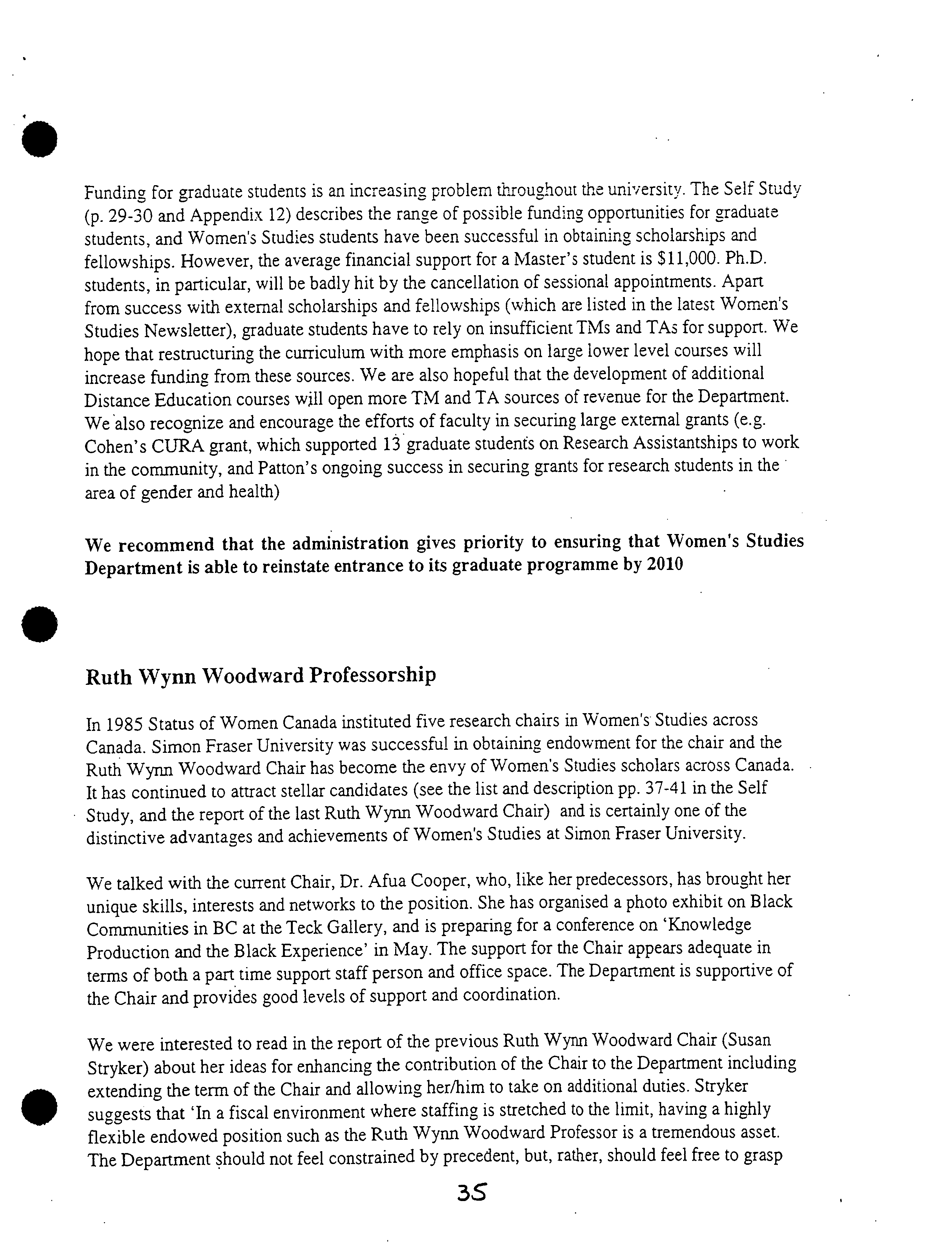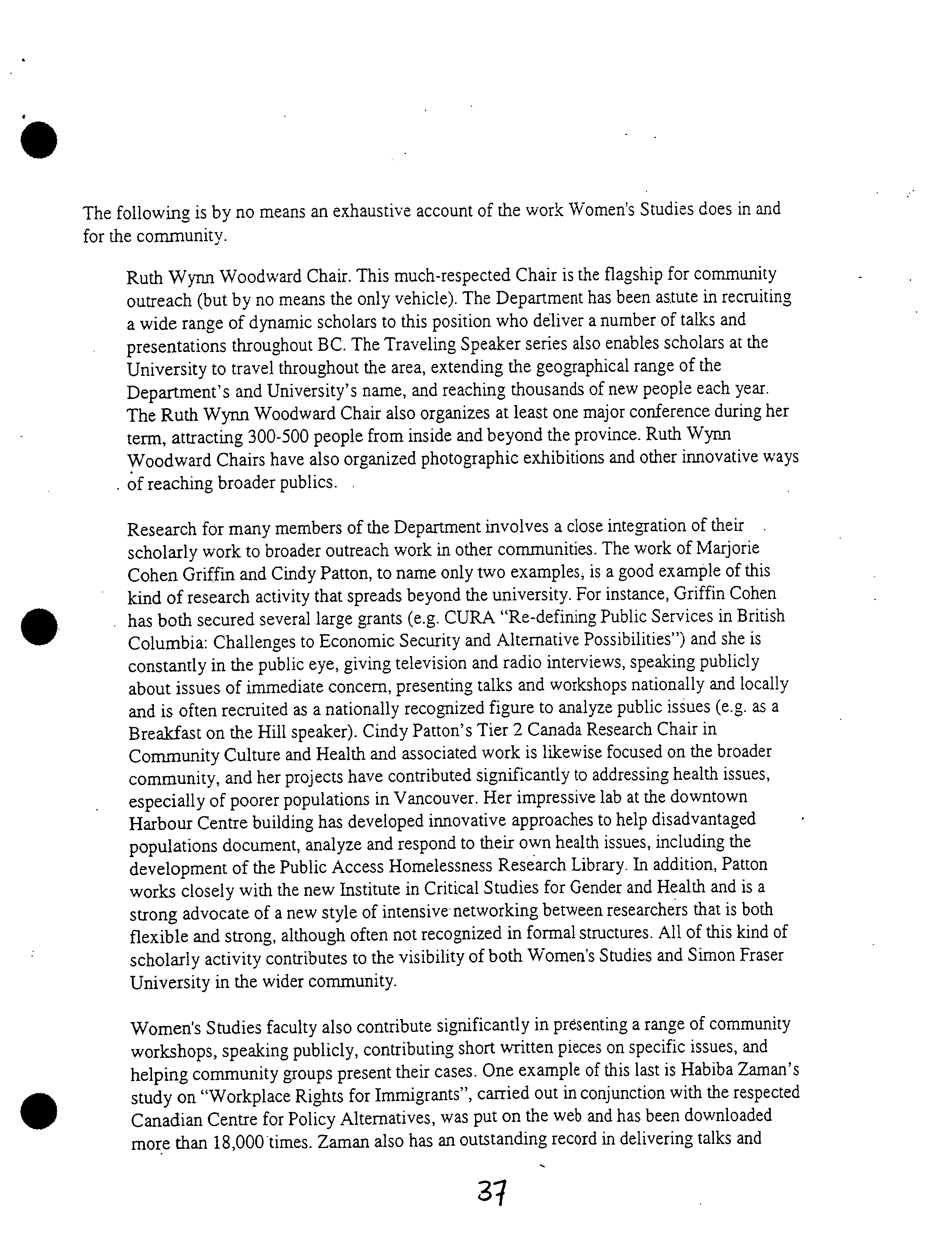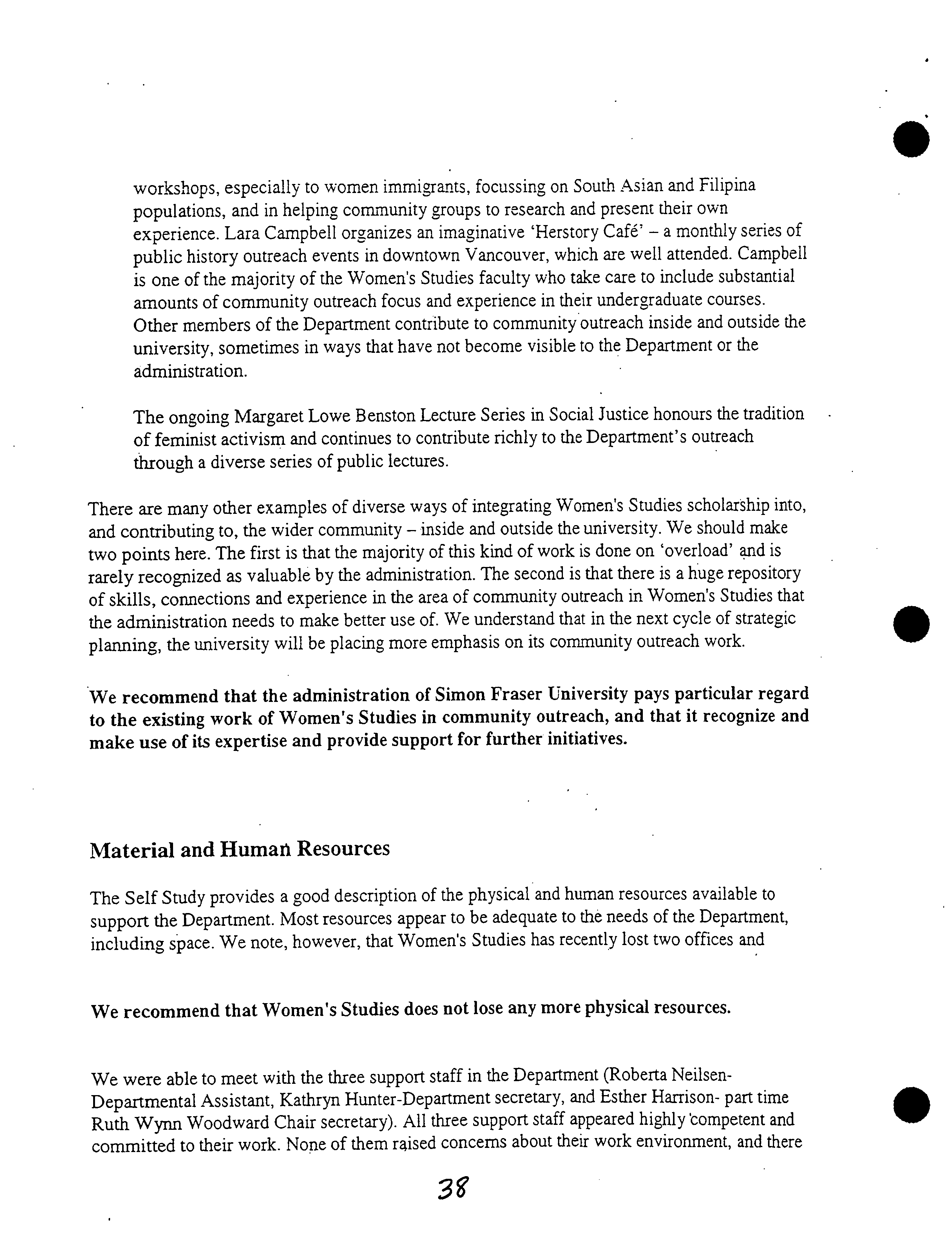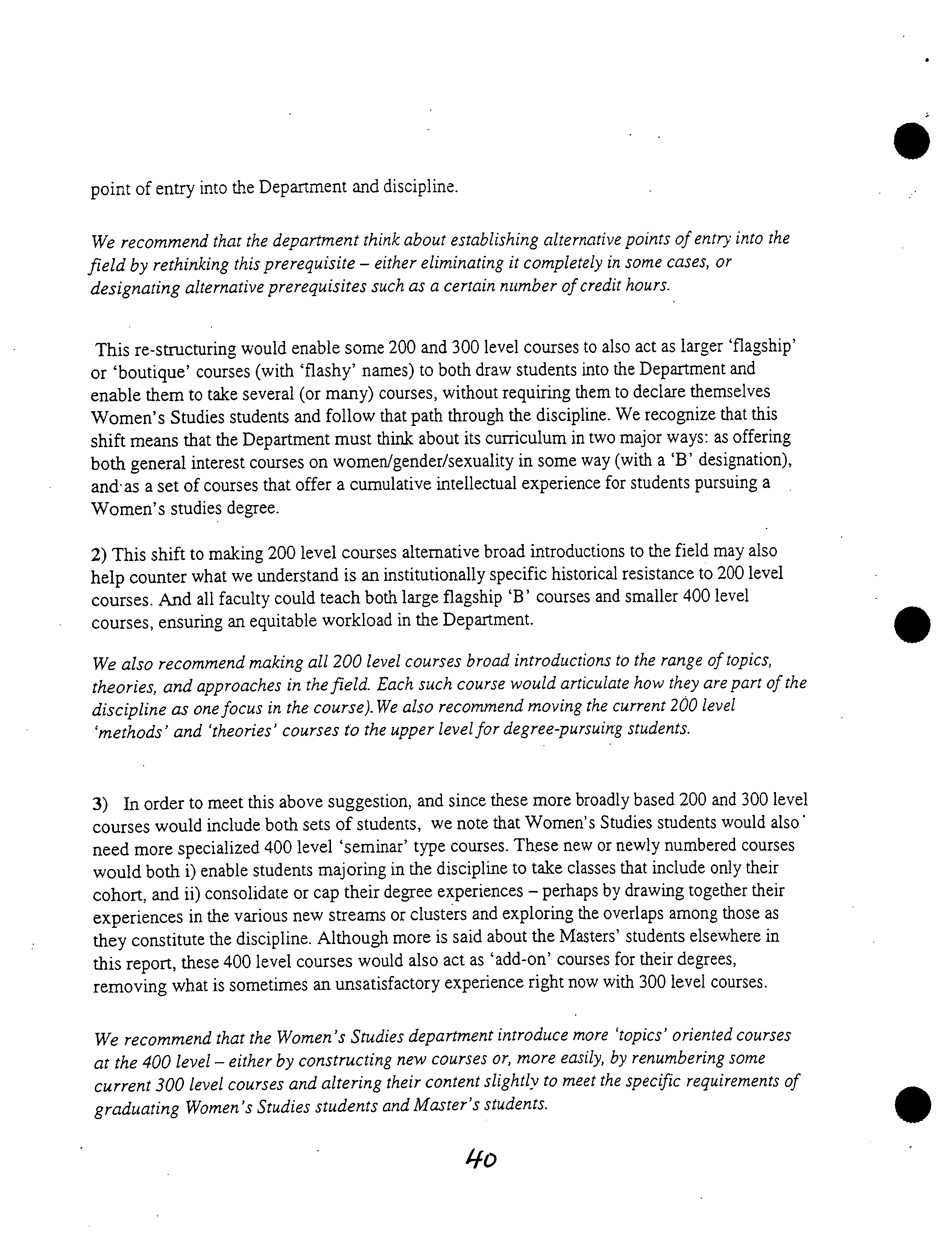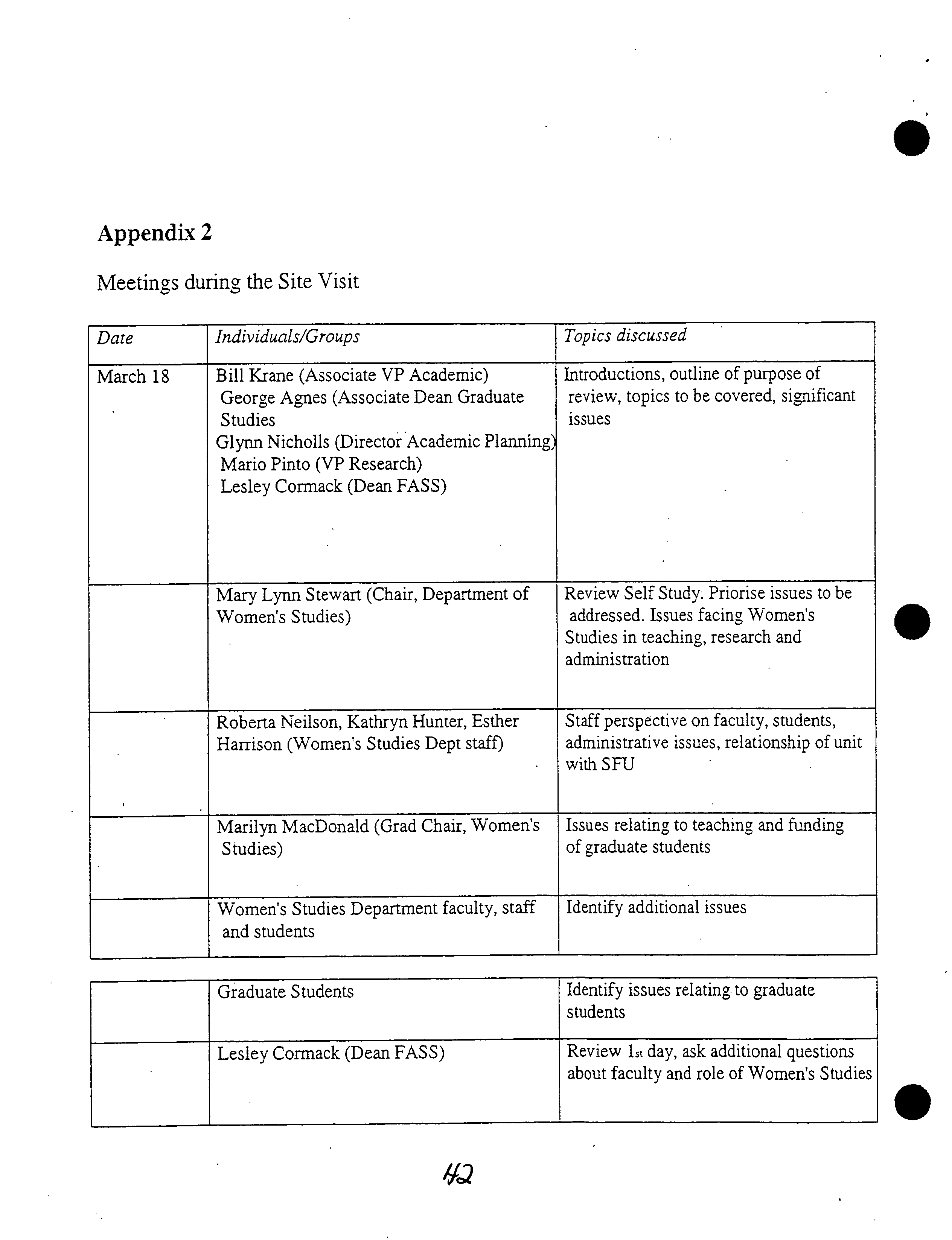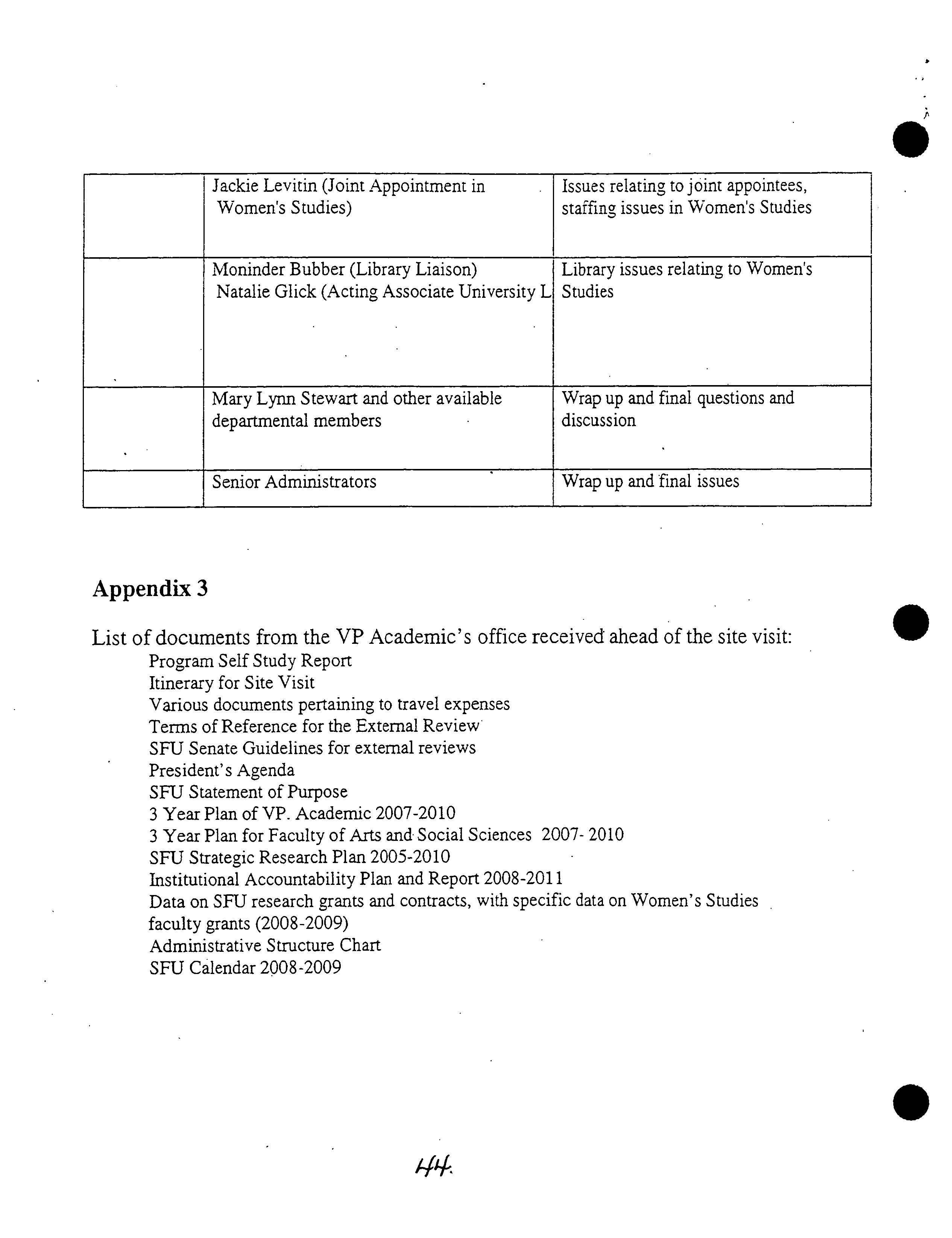
S.09-135
SIMON FRASER UNIVERSITY
.
?
Senate Committee on University Priorities
Memorandum
TO
?
Senate ?
FROM: ?
Jon Driver
Chair, SCUP and
Vice President, Acade
RE:
Department of Women's Studies
?
DATE: ?
November 24, 2004-1
The Senate Committee on University Priorities (SCUP) has reviewed tti9ternal
Review Report on the Department of Women's Studies, together with responses from
the Department, the Dean of Arts & Social Sciences and input from the Associate Vice
President, Academic.
Motion:
That Senate approve the recommendation from the Senate Committee on
University Priorities to implement the Action Plan for the Department of
Women's Studies that resulted from its External Review.
. ?
Following the review team's site visit the report of the External Review
Team*
for the
Department of Women's Studies was submitted in April 2009.
After the Report was received a meeting was held with the Dean of Arts & Social
Sciences, the Chair of Women's Studies and the Director of Academic Planning (VPA)
to consider the recommendations. The Department had prepared a response which was
discussed and responded to by the Dean in writing on September
17.
The Department
then responded to the Dean, adapted their response to incorporate the issues raised by
the Dean and developed an appropriate Action Plan in tabular format (attached).
The Review Team members were unanimous in their respect for the accomplishments
and quality of the Department of Women's Studies and declared it one of the best in the
country with a significant international reputation.
SCUP recommends to Senate that the Department of Women's Studies be advised to
pursue the Action Plan.
Attachments:
1. Departmental Action Plan
2.
Full Response of Women's Studies - June 2009 (amended September 2009)
3.
External Review Report - April 6, 2009
*
External Review Team:
Marilyn Porter (Chair) - Memorial University
Paisley Currah - City University of New York
Ann Braithwaite —University of Prince Edward Island.
CC L Cormack - Dean, Arts & Social Sciences
C Murray - Chair, Department of Women's Studies.
S
.
0
z
CL
=
1-0
'J
< ?
0
f.J
m
LU
>
LU ?
.
0
0
.
.
a)
Ocj
a) 4:
Ln
4-.
tm
L
0
ci)
kn
Ln
4-.
La)
.E
E
0
4-.
a)
a) -
0
Ea)
C -
0)
CIC
-
4-.
a)
C
ci)
C3
CC
cm
00
CC
Qj
Cc
0
cc
0)0)
4...
0'-
C
- C -- --
a)
QU
Ll
4-.
0)0
a)
4-.
00
C
. ?
-
4..
4-C
QU
'-I
C
'-4
wEc
C-4
W
CL
x
?
r
-E
0_a)
J
?
V)V)
?
(N....
u
C
0
CD
'-I
o
z
?
I-
CD
CD
x ?
>
CD
?
-a)u
Ln
cu
ci)
-
C
?
C
?
CDCO)
O
U
'-a)
?
cu
rslci)
4.
?
0
?
---
o
E
?
E ?
E
?
CD
- ?
CD ?
—a)c
o
COCDO
o
?
CDa)
CL
UL,1a)
?
0'-,,
OCD ?
Q)
ca) ?
t..a)
°E0CD ?
0
CD°to
CCD0
L)0'-
E ?
cu
?
0_-
E
-
0-c
?
C
?
Q)Na)
CD
a)
4n
?
C
O E —
CD
".O
Q)C
4-.
CU
C
cu
>-
C
?
a)
E
- ?
- ?
C
a)
?
CD
Cci)
kD
)
E
E ?
=E
0
— U
O0,m
m CA 0 vi
'-4
2.
o
r4
0
o
.—
c
0
0
(N
0
(N
—
to
LL
o
a)
r.i
o- ?
>
>
?
a)
cj-
E
Za )
.?—a)
04iv'
OD
0a)
co
C -
C
—
Ea)
Z
0
a)
C
•
Lñ ?
E
m
4-i
U
—a.0
Eo—
C0
U
5
(N
a)
C
a)
C
o
C
o
_C
U-
>
C
(
cu
?
a)
o
-
—
U>.
0
>.
(a
(a
tI..
(a
U
o
x
Ul
CL
IT
U-—
<.2
U)>
In
4-i
>.
>•u
• ?
Ca
_
tw
(a
(aC
a)
a)
a)"
CC
-
C
C0
CC
ca
L)v
E
co
a)
Ca
C.
(a
U
DEC
C
LM
-
a)
>-
a)
>-
a)
L)
0._Ca)
0 L
a)
4_' -
0C
a)
>
?
v-
>
o
(5.-I
0
v'OV
UX5ca
06
•0
> 'E
oo?J
oa)ma)
en(a
.
'4.
S
.
a)
oo
C)
wl
>
-a)
5
OO)>.
a)LL
- ?
LI)
4—
r'j ?
u
C a)
—
0
u -
E
a)
Z
-
—
I—
C)
0
0.
4-a)4-
0C)
C)
C)
C)
V
(5
-
90
CS ?
C
0Ca)-
(5
E>
E
2E
(5
a)
>(5
0oE
-c
.t
Id,
to
0 DD
U ?
-
-
LlJC)
.0 a)
- ?
4-
C
.0
a)
-
c
C
..0o
a) ?
—
5C>C
'
24-tO
?
o E
Qcj
CS> a)
(SU(5(5
k
t
(S•
o
m
0.0.4-'
.C5.cO
U ?
>-Q)
C
0
LA
4-
(S
N-
(5
C
(5VU
CQ)0
to
>.
(5
'.
0
D-U
Id, -
E
?
o
a)
-
C
-
'I-
0
O'.--
.o>
cu
CA
—
(5
-
.c ?
>.
>.
E ?
o
CU
C
(5
.
04-4-
a) C
. -
I.-
a) a)_
.c4-E
.
—4-
4—
a )
IdOa)
ct,
,. ?
a)a)
C
0)
S1.Ca)
•
-
?
. ?
I..
C
caE
)
.9 .
C)
C
(S(5
:
_c ?
(I)
- ?
?
C
U
?
Cj)
—
0
C)
0 -c
Id)
C
4 -
-
D a) Id)
o
a)
-
I-
4—
CU
?
1
4-a)
(5
E.cId.C=
•4--.-
0
cu
=
4-
a)
:
C
to
•
a)
0
a)
?
IA
m
:
LM
_c
C)
o .0
C
(3)
WC_C
(5
—
O
a)
E(5 a
)5
E
Q)
.P
a) Id
C
C^
U ?
I)
c
o
.0
_C
cu
(Dw5
..
-
cu
U
(5
i...
'
(Da)
.E
-
E
tEC°
Id)
_0a).0
a)
>
o
(5
a)
Id,
d
C
t
r_
M
C)
DZu
_(5
s-I
m
C)
4-
>.
(5
0
U.
Full Response of the Women's Studies Department to the ?
External Review Report of the Department,
?
June 2009 (amended September 2009)
The Department welcomes the External Review Report (henceforth ERR), its
recognition of the national and international reputation of the Department, and its
acknowledgement of the criticaijuncture the Department is experiencing due to
the reduction in our faculty complement and financial pressures. We agree in
principle and in most particulars with the ambitious program of changes the ERR
proposes. At a special meeting to formulate our response, followed by an
electronic referendum, the Department determined that we can implement most of
the recommendations within the suggested timelines,
if,
as the ERR also
recommends,
we are provided with the necessary resources. We reject a few
recommendations that do not reflect institutional realities at Simon Fraser
University or our experience as a Department.
In Part One. the Executive Summar
y
&
Action Plan
(pages 2 to 8), we
organize our responses by whether the responses are positive, qualified, or
negative, and within each of these categories, we subdivide by the time frame the
ERR indicated: short, medium, or long term. Next, we list specific suggestions
that were not associated with a particular timeframe and our' responses to them.
Part Two. Detailed Responses and Rationales
(pages 8 to 16), is with one
exception organized recommendation by recommendation as listed in the ERR.
Each recommendation or set of recommendations is followed by our response(s)
and the reasons for the response(s).
n
.
(0.
7
0
?
Part One: Executive
Summar y
& Action Plan
1.
Recommendations
fully supported:
1.1 Short term:
1.1.1 -that the distinction between Women's Studies and Gender
Studies be eliminated and that these two course programs be
consolidated into one and the creation of a new set of number
designations that would reflect all Women's Studies and Gender
Studies courses under a new system.
Action: The Department has already voted to consolidate the two
programs and will integrate the number designations of the two
programs this summer/fall.
1.2 Medium term:
1.2.1 -that the Department be allocated two new full time appointments,
one at the Associate Professor level, in order to both rebalance the
department in terms of faculty levels and provide faculty to enable
the Department to adequately offer its undergraduate and
graduate programs as soon as possible.
Initial response: Our next requests for faculty lines will be for an
Associate and Assistant position.
Action:
After discussion with Dean Cormack and receipt of the
Memorandum of September
17,
2009, it is agreed to table requests
for the new positions this year. See the Chair's acknowledgement
dated September 25, 2009 in tab 5.
1.2.2 -that the administration give priority to ensuring that the
Women's Studies Department is able to reinstate entrance to its
graduate program by September 2010 at the latest. (medium term)
Action: WS is accepting applications for the graduate program in
2009-3.
1.2.3 -advise the Department to look carefully at the three master's
options in view of their restricted resources.
7.
Action:
We will replace the field exams with a publishable essay to
cap the course-intensive option.
1.2.4 -We would encourage the growth of the Ph.D. program in
particular. It is both a strength and a hallmark of the Department
(long term).
Action:
We agree with this recommendation and assessment.
1.2.5 -that the Department discuss how to make their community
outreach more visible and how to recognize and articulate
individual activities as part of a coherent departmental effort.
(medium term)
Action:
The Department will insert a page on Community Outreach to
the Departmental website. It would help if FASS had a mechanism to
make the outreach activities of all faculty members more visible and
valued.
1.2.6 -that the Department explore streamlining its Joint Ma or degree
options, perhaps by standardizing the Women's Studies
requirement so that they are the same for each program (medium
term)
?
9
Action:
The Department will make appropriate changes in the two
Women's Studies joint majors whose requirements are different than
the rest, when the four faculty members of leave next year return (i.e.
2010-2011).
1.3 Lon
g
Term:
1.3.1 -that the administration pay particular regard to the existing work
of Women's Studies in community outreach, and recognize how
this work extends and contributes to the university's growing
reputation locally, nationally, and internationally and that it
recognize and make use of its expertise and provide support for
further initiatives. (long term)
Action:
We will provide more regular information about our extensive
community outreach to the Dean.
1.4 No specified time frame:
1.4.1 -that Women's Studies does not lose any more physical resources.
IN
4
. ?
Amen!
2. Recommendations partially supported:
2.1 Short term:
2.1.1 -that funds be made available from the administration
immediately to facilitate this process (revising curriculum and
courses).
Action:
WS supports funding such extensive revisions to our
curriculum but given the current financial situation, asks only two
course releases for the Undergraduate Chair and sessional funding to
cover these course releases.
2.2
Short and medium term:
2.1.2 -that the department extend invitations to more faculty
.
?
members—especially but not limited to recent appointments—who
do feminist research on women, gender, and sexualities in other
units of the university to become Associate Faculty members, and
that it create alternate ways to welcome and integrate these
Associates into the intellectual life of the Department.
Action:
WS will add Associates but cap the number at eighteen at any
one time to ensure that we have enough faculty members to serve as
internal/external examiners for our graduate students. We will
continue to put Associate Faculty on our mailing lists and to offer a
yearly luncheon for recent Associate Faculty members. Assuming that
we will have enough faculty members in 2010-2011, we will appoint a
faculty member to take responsibility for faculty liaison.
2.1.3 -that the Department actively explore the possibility of more cross-
listed courses that reflect the breadth of work on gender and
sexuality being done in other institutional locations.
Action:
The Department will ask our Associates and potential
Associates teaching in the areas of gender/women/sexuality about
cross listing their courses. We will also ask Associates about
0
?
designating WS courses for credit in their departments.
2.2
Medium Term:
2.2.2 -that the current CODE allotment of distance education courses be
increased to at least
two courses a
year.
Action:
Although we support this recommendation, we cannot comply
unless CODE chan g
es its stated policy of supporting only one new
or
adapted WS course a
year.
We are already committed to adding three
new courses, including GDST 200, in the next three years.
2.2.3 -that the Department reflects on how to better integrate the Ruth
Wynn Woodward Chair into the thinking and resources of the
Department, by building more flexibility into the Chair's
responsibilities and possibilities, including enhancing the
contribution of the chair to the Department, perhaps by extending
the term of the chair and allowing her/him to take on additional or
other duties, as the need and/or interest arises. (medium term)
Initial response: We will write more flexibility about the length of the
term (i.e. one year with the possibility of renewal for one year) into
advertisements for the Chair, so that a particularly appropriate
incumbent might legally be asked to stay a second year. We will seek
an agreement with the Administration that a Chair might be considered
fOr a permanent position after their term expires.
Our expectations of the Endowed Chair are constrained by its terms of
reference, which requires the Endowed Chair to put at least as much
emphasis on public outreach as on their contribution to the
Department. The reviewers seem unaware of this constraint.
Action:
In subsequent discussion with the Dean after the cuts to the
TI/TA
budget eliminated the
matchedAF-4
equivalent in place for
many years in the RWWP chair, it was agreed to explore the
financial accounting history of the chair and look for ways to
support the program. The Department agreed to seek either a
shorter appointment or post-doctoral modelfor 2010-2011, but also
asked to work with the Dean to seek ways to stabilize the Endowed
Chair under its previous levels in time for the 25th anniversary
celebrations with the four other such chairs established by the Status
of Women Canada
2.3 Specific Recommendations, without a timeline:
2.3.2 -advise the Department to look carefully at the master's degree
requirements, in view of their restricted resources.
0
f0
o
?
Action: We are going to eliminate the most labour-intensive of the
?
three options for a master's degree.
2.3.3
-that the department think about establishing
alternative points of
entry into the undergraduate programs by rethinking the WS 101
and WS 102 prerequisites - either eliminating it completely in
some cases, or designating alternative prerequisites such as a
certain number of credit hours.
Action: We have sent a proposal to replace these prerequisites in 11
courses either with no prerequisites or six to fifteen credits in WS or
GDST. Our major and minor requirements will be reviewed next year,
to ensure a reasonable progression of courses leading to these degrees.
2.3.4 -making all 200 level courses broad introductions to the range of
topics, theories, and approaches in the field. Each such course
would articulate how they are part of the discipline as one focus in
the course,
Action: Most of our 200 level courses are broad introductions and we
are only accepting one change in 200 level courses that does not
r
?
conform to this tradition. We are submitting to FASCC .a new, open-
access lecture course, WS 204, "Sex in the City," which several of our
faculty can teach and which should attract students who might
otherwise not choose WS.
2.3.5 -movin
g
the current 200 level 'methods' and 'theories' courses to
the upper level for degree-pursuing students.
Action: We prefer to keep the feminist theory and methods course at
the 200 level, but have a proposal to amalgamate them as WS 203,
"Feminisms, Ideas and Approaches." This seems to fall under the
rubric of breadth at the 200 level.
2.3.6 -that the Women's Studies department introduce more 'topics'
oriented courses at the 400 level (seminar style) - either by
constructing new courses or, more
easily, by
renumbering some
current 300 level courses and altering their content slightly to meet
the specific requirements of graduating Women's Studies students
and Master's students.
Action: We will consider this recommendation at an August 19th
• ?
meeting on curricular reform, guided by two objectives: ensuring that
these courses meet the needs of our minors and majors for a coherent
program of studies and that the courses to which we attach graduate
rel
'I
3
add-ons, have pre-requisites and course content that justify a graduate
add-on.
Update: August the IV
"
saw overwhelming ratification of an
agreement to change our name to better reflect the amalgamation of
the program (see Memo Attached under tab 6), and with i4 extensive
curriculum changes, which are now set out in the Three Year Plan
and will be working their way to Senate.
2.3.7
A
few additional suggestions: i)
remove the word 'introduction'
from the first year courses and find alternate names (without
necessarily changing content) to capture broader range of
students; ii) use the words 'social justice' in at least one course -
existing or a new 100 level course - to both capture the grade 12
social justice course interest and as a possible alternative 100 level
requirement for the degree programs.
Action:
We will rename our two 100 level courses "Thinking About
Women" and "Thinking about Feminism," Given appropriate faculty
resources, we will add a "Thinking About Gender" course at the 100
level and a Social Justice course, likely at the 200 level.
Recommendations rejected:
3.1
Medium term:
3.1.1 -that a future Ruth Wynn Woodward Chair could be recruited to
contribute specifically to the development and growth of
departmental identity and vision as a premier Women's Studies
Department in Canada and that in the next
two
years the
Women's Studies Department consider appointing a Ruth Wynn
Woodward Professor with specific skills in the area of developing
a Women's Studies identity to help focus their thinking and
planning. (medium term)
Rationale:
We believe that developing departmental vision and
identity is best accomplished by engaging everyone in the department
in the process and will request funding for another visioning exercise
when we have a better picture of future faculty resources. Twenty-two
years of experience advertising for RWW Chairs informs our
adherence to the practice of advertising for applicants with a range of
academic and activist expertise to ensure an adequate candidate pool.
3.1.2 - that the administration consider the pedagogical and course
content implications of the increasin
g
ID
diversity of the student
r
L
fl
12
.
.
body, and if necessary, funds should be made available to enable
them to update and revise their courses.
Rationale:
We believe that WS has reflected the increasing diversity of
the student body.
New faculty would allow us to expand our catchment, by teaching more
courses on public policy and on masculinity and by introducing a
course on Social Justice.
Part Two, Detailed Responses and Rationales
4. Recommendations in response to the Five Questions posed to the
reviewers.
4.1 -strongly recommend that the Department be allocated two new
full time appointments, one at the Associate Professor level, in order
to both rebalance the department in terms of faculty levels and
provide faculty to enable the Department to adequately offer its
undergraduate and graduate programs as soon as possible. (medium
term)
WS a
g
rees with this recommendation, which reflects our requests for CFL faculty
lines since 2004 and responds to the retirement of four faculty members over the
past six years. We have submitted a request for two Assistant Professor positions
this coming year in consideration of the financial situation.
In the medium term, we will ask for an Associate and Assistant, and as the three
faculty members approaching the age of normal retirement retire, we will seek
replacements, although not necessarily in precisely the same fields.
4.2 -that the department extend invitations to more faculty
members—especially but not limited to recent appointments—who do
feminist research on women, gender, and sexualities in other units of
the university to become Associate Faculty members, and that it
should create alternate ways to welcome and integrate these
Associates into the intellectual Life of the Department. (short and
medium term)
WS agrees with the intent of this recommendation, which we have to some degree
pursued, but do not want its implementation to reduce the number of faculty that
our Graduate Program can call upon for internal/external examiners for thesis and
dissertation. defenses.
13
We currently have twelve Associate Faculty members from five departments; four
of them were added in the past
year,
when one Associate retired and another will
retire. We will add more Associate to our roster but cap their number at eighteen
at any one time. The recent introduction of a limited term as Associate Faculty,
with the option of renewing, or not renewing, every three years, should allow us
to draw upon more than eighteen faculty members over time.
As for welcoming Faculty Associates, we have always put them on our mailing
lists to be informed about any public events and special seminars and invited them
to participate in our recent campus-wide colloquium on the body. This year we
held a luncheon for recently-appointed Associates, at which we provided them
with information about our programs, answered any questions they had about the
programs, and requested input on what they were doin
g
that might interest our
students. The response was positive and we will continue to do this yearly.
For the medium term, we are considering appointing a faculty member to take
responsibility for faculty liaison. We will not be able to do this next year, when
our faculty complement is nearly depleted due to four study leaves and four
retirements without replacements.
5. Undergraduate Program
5.1 -that the distinction between Women's Studies and Gender
Studies be eliminated and that these two course programs be
consolidated into one and the creation of a new set of number
designations that would reflect all Women's Studies and Gender
Studies courses under a new system. (short and medium term)
At the special meeting to consider the External Review on 8 May 2009
(confirmed by an electronic poll of all voting members), the Department voted to
consolidate the two pro
g
rams. A decision about consolidation, which we
discussed previously, had been postponed until after the External Review.
We have scheduled a special curriculum meeting of the department on 19 August
2009, when we will decide on a new name for the department and create an
integrated system of course numbers. These changes will be brought to the FASS
Curriculum Committee in the fall of 2009.
5.2 -that the Department explore streamlining its Joint Major degree
options, perhaps by standardizing the Women's Studies requirement
so that they are the same for each program (medium term)
The Department will make appropriate changes to the two Women's Studies joint
majors whose requirements differ from the other joint majors, but not until 2010-
2011, when there will be more faculty members available to work on the medium-
.
S
.
10
term recommendations. We will need to consult with the other departments
involved, which might further delay
?
val of the changes.
5.3 -that the
Department
actively explore the possibility of more
cross-listed courses that reflect the breadth of work on gender and
sexuality being done in other institutional locations.
The Department has qualms about significantly increasing the number of cross-
listed courses with other departments, because enrollments more often accrue to
the other departments. As long as the University is committed to increasing
enrollments and its current system of rewarding departments on the basis of
enrollments, we only commit to consulting with our associates and potential
associates who teach in the areas of gender/women/sexuality about cross listing
their courses.
We will also explore having courses in WS designated for credit in other
departments—as we have done with WS 201, 202 and
306
for nearly two
decades—because enrollment in these courses count toward our enrollment. The
presence of faculty members jointly appointed with WS in the other department
that designated our courses facilitated their designation. In so far as the three
remaining joint appointments have not pursued this option, we will investigate
whether Associate Faculty would vouch for the scholarly and pedagogical quality
of any courses we wanted to be designated. We can only hope that the University
algorithm fo enrollment accounting will not undermine this kind of initiative.
5.4 -that the current CODE allotment of distance education courses
be increased to at least two courses a year. (medium term)
We support this recommendation, but having been informed, when we
approached CODE last spring with an ambitiouS plan to increase the number of
WS courses on line, that CODE could only support one new or adapted WS
course a year for the next three years, we decided to add three new courses,
including GDST 200, in the next three years. We revised two long-time Distance
Education courses, specifically to be on-line courses, in 2007-8 and 2008-9.
We think it might be useful to assess the success of the first two new courses after
they were offered once or twice, before committing to two new courses a year.
Once again, new faculty members would make this program of course creation
more feasible for a small department.
5.5 -The re-organization and streamlining of the
program will
entail
the revision of some courses and the re-writing of others. We
recommend that funds be made available from the administration
immediately to facilitate this process. We further recommend that the
administration consider the pedagogical and course content
implications of the increasing diversity of the student body, and if
IS
necessary, funds should be made ava
i
lable to enable them
to update
and revise their courses.
?
0
WS certainl
y
supports funding such extensive revisions to our curriculum. In so
far as there has been no University or FASS funding for this kind of essential
pedagogical work in our collective memory (or are we misinformed?), we have
proceeded with revisions and streamlining. With the integration of Women's
Studies and Gender Studies and the resulting curricular overhaul, we would like a
commitment from administration for the following resources:
o two course releases for the Undergraduate Chair
o funds for sessionals to cover these course releases.
Last summer, when we explored the possibility of inviting a curricular specialist
in post-secondary instruction in WS to a day-long workshop, we found the cost of
the closest one (a professor of Education at UBC) prohibitive for a department
with a budget under $17,500.00. Travel and accommodation costs would make
distant specialists more expensive. Perhaps the Administration should employ
curricular consultants to help the many departments trying to implement new
directives about more lecture, on-line, and alternative courses.
As for the implication that WS has not reflected the increasing diversity of the
student body, we totally reject the implication. A short list of our initiatives to
increase diversity includes:
• offering Distance Education (now CODE) courses since the early 1990s and
creating more CODE courses to serve students that cannot come to campus
• offering courses on race and gender since the mid-1990s,
• appointing six Ruth Wynn Woodward Chairs who specialized in the history,
sociology and literature of women of colour as well as one who specialized in
transgender (and all left a mark on our courses)
• introduced the GDST minor in 2004 to cater to more men, gay, bisexual and
transgender students;
• made liberal use of Humanities and Social Science Breadth designations to
draw students from other faculties, notably Science and Business;
• are changing WS 102 from Western Feminisms to Westein and Global
Feminisms, prior to renaming it Thinking about Feminism;
• and conducted a study of ways of appealing to high school students that
recommended, among other things, contacting teachers of the new high school
course on social justice with offers to either visit their classes or host their
classes in one of our introductory courses. This initiative was premature, in so
far as the teachers participating in the trial run for this new high school course
were not interested. We will try to contact teachers once they are more
accustomed to teaching the course.
IC',
I'?
New faculty would allow us to expand our catchment by' teaching more courses
on public policy and on masculinity and introducing a course on Sociai Justice to
attract high school recruits who have no instruction about WS or GDST in high
school, but who may have taken the new hi
g
h school course. on Social Justice.
Regretfully, among the five courses that we propose to drop in response to the
FASCC directive to eliminate courses without a dedicated faculty member to
teach them is Women and Religion, which has focused on women or feminism in
Islamic cultures in recent years.
6.
Graduate Programs
6.1 -that the administration give priority to ensuring that the
Women's Studies Department is able to reinstate entrance to its
graduate program by September 2010 at the latest. (medium term)
WS has already announced that we will be accepting applications for the graduate
program in 2009-3. More faculty members would make this a more viable option.
The following is slightly out of order but relates to the graduate program.
6.2 -advise the Department to look carefully at the three master's
options in view of their restricted resources.
We will replace the field exams, which are the most labout-intensive, with a
publishable essay to cap the course-intensive option. We voted to do this in 2008-
3 but have been preoccupied with preparing for and responding to the external
review.
6.3 -encourage the growth of the Ph.D. program in particular. It is
both a strength and a hallmark of the Department (long term)
This recommendation, which we wholeheartedly support, would be easier to
implement if the department had a full complement of faculty in WS/GDST.
We need to replace faculty who are likely to retire in the next two or three years
and who have ceased taking new PhD students, because they may not be available
to supervise PhDs to completion.
7.
Community Outreach
7.
1 -that the administration pay particular regard to the existing
work of Women's Studies in community outreach, and recognize how
this work extends and contributes to the university's growing
.
?
reputation locally, nationally, and internationally and that it
recognize and make use of its expertise and provide support for
further initiatives. (long term)
.
We support this recommendation and will contribute to its realization by
providing more regular information to the Administration (see below).
7.2 -that the Department discuss how to make their community
outreach more visible and how to recognize and articulate individual
activities as part of a coherent departmental effort. (medium term)
Inferring from this recommendation that our annual (hard copy and on-line)
Newsletter is inadequate to the task, we will put a new page on our website with
updated information about our activities. The Chair, who will expand her efforts
to inform the Administration about our outreach activities, would appreciate
Administrative guidance about how to do this effectively. We have a suggestion:
a mechanism within FAS S to make the extensive outreach efforts of all faculty
members, not just those in WS, more visible, better regarded and even rewarded.
8. Ruth Wynn Woodward Professorship
8.1 -that the Department reflects on how to better integrate the Ruth
Wynn Woodward Chair into the thinking and resources of the
Department, by building more flexibility into the Chair's
responsibilities and possibilities, including enhancing the contribution
0
of the chair to the Department, perhaps by extending the term of the
chair and allowing her/him to take on additional or other duties, as
the need and/or interest arises. (medium term)
Until the past five years, the Department was flexible about the length of the term
for the Ruth Wynn Woodward's Chair (from one semester to four years).
However, we noticed that longer terms encouraged some incumbents to withdraw
from involvement in the last year of their term and others to develop expectations
about permanent appointments that the Department was unable to fulfill.
Accordingly, we have for the past five years advertised for one-year
appointments. When we inquired about extending a one-year term, Gayle Myers
informed us that an advertisement that specified a one-year term could not be
extended.
Two responses to the ERR suggestions are:
o specifying in advertisements for applicants for the Chair that we would
consider one or two year terms, so that a promising incumbent might legally
be asked to stay a second year.
o an agreement with the Administration that a Chair would be considered for a
permanent position after their term, which would have the added advantage of
addressing the particularly difficult hiring situation in FASS at this time.
1.)
S
r
IF
.
.
14
As for the suggestion that the Endowed Chair should contribute more to the
Department, the terms of reference for the Endowed Chair put at least as much
emphasis on the public outreach component of the Chair's responsibilities as on
their contribution to the Department. We are reluctant to do anything that can be
construed as improper stewardship of the Chair.
8.2 -that a future Ruth Wynn Woodward Chair could be recruited to
contribute specifically to the development and growth of
departmental identity and vision as a premier Women's Studies
Department in Canada.
The Department is working on its vision, beginning with a visioning workshop
last spring and continuing in our external review retreat and Self Study. We intend
to remain a leader among Women's Studies Departments in Canada but are not
persuaded that hiring a Chair with skills in developing a WS identity would be the
best way to accomplish this. We think that the whole Department needs to be
filly engaged in this process. Funding for another visioning exercise, especially
when we have a better picture of our faculty resources in the future, would be
useful in this regard.
8.3 -that in the next two years the Women's Studies Department
consider appointing a Ruth Wynn Woodward Professor with specific
skills in the area of developing a Women's Studies identity to help
focus their thinkin
g
and planning. (medium term)
At a very practical level, we are concerned that advertising for such a specialist
might significantly limit the number and perhaps quality of the applicants for the
Chair. It might be possible to indicate in an advertisement, that we encourage
applicants with this kind of expertise, and other kinds of expertise, to ensure more
applications. Broad advertising has served us well in the past, and there is no
reason to believe that this practice will not work in the future.
9. Material and Human Resources
9.1 -that Women's Studies does not lose any more physical resources.
Amen! The recent loss of three more offices (bringing our total losses to five
offices) has meant that our department cannot offer TAs, sessionals and PhD
candidates the accommodations other departments, includin
g the one that has
taken over our former offices, provide their teachers and graduate students.
n
t:J
15
10. Some additional suggestions about curriculum and programming
for
the
department:
10.1 -that the department
think about establishing alternative points
of entry into the field by rethinking this prerequisite (WS 101 and/or
WS 102) - either eliminating it
completely in some cases, or
designating alternative prerequisites such as a certain number of
credit hours.
We have voted to eliminate these prerequisites from 11 courses, replacing them
with no prerequisites or six to fifteen credits in WS or GDST. Our major and
minor requirements will be reconsidered next year, to ensure a reasonable
progression of courses leading
to
these degrees.
10.2 -making all 200 level courses broad introductions to the range of
topics, theories, and approaches in the field. Each such course would
articulate how they are part of the discipline as one focus in the
course.
We are examining our 200 level courses, most of which already are broad
introductions, with this recommendation in mind and, in the interval, are only
accepting changes that are broad. We are also submitting for approval a new,
open-access, no-prerequisite course, WS 204, called Sex in the City, to be taught
as a lecture course, which we believe will attract students who might otherwise
not choose WS.
10.3 -moving the current 200 level 'methods' and 'theories' courses to
the upper level for degree-pursuing students.
We prefer to keep the feminist theory and methods course at the 200 level, for
pedagogical reasons, but are submitting a proposal to merge the two courses into
one, WS 203, entitled Feminisms, Ideas and Approaches, in our June 2009
submission to FASCC. This merger respects the recommendation to make 200
level course broad introductions and allows more of our faculty members to teach
the course.
10.4 -that the Women's Studies department introduce more 'topics'
oriented courses at the 400 level (seminar
style) - either by
constructing new courses or, more easily, by renumbering some
current 300 level courses and altering their content slightly to meet
the specific requirements of graduating Women's Studies students
and Master's students.
We will consider this recommendation at the August 19" meeting on curricular
reform, mentioned above. We will be guided by two intersecting agendas:
ensuring that these courses meet the requirements of our minors and majors and
16
that the courses to which graduate add-ons are attached, have the pre-requisites
and course content appropriate to have an add-on.
10.5 -A few additional suggestions: I) remove the word 'introduction'
from the first year courses and find alternate names (without
necessarily changing content) to capture broader range of students; ii)
use the words 'social justice' in at least one course -
existing or
a new
100 level course - to both capture the grade
12
social justice course
interest and
as a
possible alternative 100 level requirement for the
degree programs.
We have had a preliminary and positive discussion about removing the word
"introduction" and replacing the current titles of the 100 level courses with titles
such as "Thinking About Women" and "Thinking about Feminism." If we could
count on new faculty lines, we would add a "Thinking About Gender" course at
the 100 level. See above about a course on Social Justice.
Respectfully submitted,
Mary Lynn Stewart for the entire Department of Women's Studies
0
JI
External Review Report
Women's Studies Department
Simon Fraser University
External Reviewers:
Marilyn Porter University Research Professor Department of Sociology Memorial University E-
mail:
mporter@mun.ca
Paisley Currali Associate Professor Political Science and Women's Studies Brooklyn College
City University of New York E-mail:
pcurrah@brooklyn.cunv.edu
Ann Braithwaite Associate Professor Women's Studies University of Prince Edward Island E-
mail:
abraithwaite@upei.ca
Submitted April 6, 2009
Executive Summary
The external review team is unanimous in our respect for the accomplishments and quality of the
Women's Studies Department at Simon Fraser University. It remains one of the best Women's
Studies departments in the country, and also has a significant international reputation. However,
the Department is at a critical juncture. A series of losses of faculty coupled with increasing
fiscal restraint have pushed it to the point of unsustainability. On a more positive note, we think
that the crisis does offer the opportunity to re-think and revise their current programmes. In
moving forward in this revisioning process, the Department can build on its strengths, taking
advantage of new thinking and creating innovative opportunities. This will require support of
various kinds (not just faculty renewal) from the administration, but the result will be a
programme that both optimizes its resources and is a robust and invigorated Department, able
and ready to take a leadership position in the university.
While we understand the difficulties facing the university as a whole and all the units in it, we
have been struck by what seems to us to be a number of unnecessarily complex bureaucratic
hurdles and procedures. When departments are being asked to change and reform, it would be
helpful if the streamlining process extended across the university as a whole. We feel that this is
also true of the way in which statistics and other records are collected and used. We found a
number of examples where the administration appears to calculate departmental effort in ways
that do not take account of the complex limitations of a small department with a number of joint
S
.
c2c3
appointments or faculty having major responsibilities outside. the Department. In addition,
Women's Studies is, by any counting scheme, a small department. Experience elsewhere
indicates that schemes designed for the whole university tend to discriminate against such
smaller units--for example, by underestimating the effect of the loss of one faculty member, or
by 'rounding down' calculations of faculty/student ratios.
In a short report, we cannot provide the rich detail about either the Department's successes and
strengths or about the challenges that it faces that we would like, but the ample documentation
provided by both the administration and the Department has enabled us tç make a coherent series
of major and minor recommendations. Our major recommendations are summarized below, and
the more minor ones - mostly at the departmental level - are included in, an appendix.
The Five Questions
The Terms of Reference provided to us outlined some general areas that we should document
and comment on, but also laid out five issues that the administration and the Department wanted
us to pay particular attention to. We provide our major suggestions and recommendations on
these five issues below. We also indicate whether we see the implementation of these
recommendations as being short term (within 3 months), medium term (within 3 years), or
•
longer term (3-5 years). Further rationale for these recommendations is provided in the body of
this report.
a)
Evaluate the impact of recent and expected future faculty retirements on the Department.
4 ?
We strongly recommend that the Department be allocated two new full time
appointments, one at the Associate Professor level, as soon as possible. (medium term)
4 ?
We recommend that the department extend invitations to more faculty
members—especially but not limited to recent appointments—who do feminist research on
women, gender, and sexualities in other units of the university to become Associate Faculty
members, and that it should create alternate ways to welcome and integrate these
Associates into the intellectual life of the Department. (short and medium term)
b)
Consider future directions for the Gender Studies minor and the potential for expanding the
Graduate Studies program, including collaborations with other departments and programs.
Undergraduate program:
4 ?
We recommend that the distinction between Women's Studies and Gender
Studies be eliminated and that these two course programs be consolidated into one. We
further recommend the creation of a new set of number designations that would reflect all
Women's Studies and Gender Studies courses under a new system. (short and medium
Is
term)
4 ?
We recommend that the Department explore streamlining its Joint Major
23
degree options, perhaps by standardizing the Women's Studies requirements so that they
are the same for each program. (medium term)
?
• ?
We recommend that the Department actively explore the possibility of more
cross-listed courses that reflect the breadth of work on gender and sexuality being done in
other institutional locations. (medium term)
?
• ?
We recommend that the current CODE allotment of distance education
courses be increased to at least two courses a year. (medium term)
?
•
?
The re-organization and streamlining of the programme will entail the
revision of some courses and the re-writing of others. We recommend that funds be made
available from the administration immediately to facilitate this process. We further
recommend that the administration consider the pedagogical and course content
implications of the increasing diversity of the student body, and if necessary, funds should
be made available to faculty to enable them to update and revise their courses. (short term)
Graduate Programs
?
• ?
We recommend that the administration give priority to ensuring that the
Women's Studies Department is able to reinstate entrance to its graduate programme by
September 2010 at the latest. (medium term)
?
• ?
We would encourage the growth of the Ph.D. programme in particular. (long
term)
c)
Identify the research strengths of the Department and suggest possible new strategies or
initiatives for the future.
• We are impressed by both the quality and the depth of the research activity in the
department. While there are clear strengths, for example in public policy and in gender
and health, we would argue against insisting that there be specific, but limited, research
foci in the department. New faculty may well bring completely different but equally
valuable research interests. The Department is already exploring a wide range of sources
for funding, and while in a time of fiscal restraint they should continue and extend these
efforts, neither should they nor the administration discriminate against those faculty
whose research activities do not mesh with obtaining large external grants. We have no
specific recommendations in this area.
d)
Review the effectiveness of the Department's community outreach initiatives.
?
?
• ?
We recommend that the administration pay particular regard to the existing
work of Women's Studies in community outreach, and recognize how this work extends
and contributes to the university's growing reputation locally, nationally, and
.
c2L1
o
internationally. (long term)
• ?
We recommend that the Department discuss how to make their community
outreach more visible and how to recognize and articulate individual activities as part of a
coherent departmental effort. (medium term)
e) Assess the Department's stewardship of the Ruth Wynn Woodward Endowed Chair in
Women's Studies.
• ?
We would suggest that the Department reflects on how to better integrate the
Ruth Wynn Woodward Chair into the thinking and resources of the Department, including
enhancing the contribution of the chair to the Department, perhaps by extending the term
of the chair and allowing her/him to take on additional or other duties, as the need and/or
interest arises. (medium term)
• ?
We would further suggest that a future Ruth Wynn Woodward Chair could
be recruited to contribute specifically to the development and growth of departmental
identity and vision as a premier Women's Studies Department in Canada. (medium term)
i s
Background and Context
Women's Studies at Simon Fraser University began 30 years ago in 1976, one of the earliest
programmes to develop Women's Studies as an intellectual discipline in Canada, or, indeed, in
the world. The intervening years have seen (sometimes slow but) steady growth in all areas, with
significant highlights along the way, including the inception of the Ruth Wynn Woodward Chair
in 1985 and the introduction of the Ph.D. programme in 2004, one of only five such programmes
in Canada. The Department currently serves 775 undergraduate and 23 graduate students, with a
core staff of five full time faculty, and with some help from the three joint appointments and
from the Ruth Wynn Woodward Chair.
From its inception, Women's Studies at Simon Fraser became a significant actor in the
development of the discipline across Canada. Its scholars were, and are, nationally and
internationally recognized; its graduates moved on to become significant players inside and
outside the university. It remains a powerhouse, with a national and international 'clout' beyond
what its size might suggest. It is one of the leading Women's Studies departments in Canada with
a continuing high reputation for teaching, publications, multi-disciplinary major research
projects, contributions to theoretical discussions about the future of the discipline, and leadership
in feminist scholarly associations and publications.
• ?
As a nexus of interdisciplinary scholarship and teaching, Women's Studies links to a multiplicity
of other areas and disciplines. Its role as a key focal point is. exemplified by the range of cross-
listed course, joint majors and minors, and joint and associate faculty. It continues to provide real
strengths to the university in this way. Since the 1970s, however, Women's Studies has also
OZ
developed as a discipline, evolving as all other disciplines have--by developing a sense of
cohesion, a shared set of texts and references, a distinct (although fluid and evolving) body of
theory and methodology, a set of shared values and priorities (always contested), and a
distinctive pedagogy and 'atmosphere'. In all these ways Women's Studies at SFU has
contributed significantly to the development of the discipline of Women's Studies.
However, in 2009, Women's Studies at Simon Fraser University finds itself at a critical juncture.
In our view, its diminishing resources (mostly as a result of recent and continuing loss of faculty)
has reached the point of unsustainability. In recent years, the administration has made many,
sometimes contradictory, demands on the Department, such as giving priority to both higher
enrollments and an enhanced research programme. Like other small departments, Women's
Studies has suffered disproportionately from both larger proportional losses of resources and
from discrimination in the various statistical evaluations that use methods that inevitably under-
represent the Department's efforts and achievements. In our view, the Department has
systematically endeavored to achieve the targets set by the administration in all areas—
enrollments, grants, publications, and so on. The Women's Studies Department at Simon Fraser
has the potential to continue to grow and remain one of the leading Women's Studies
departments in the country. Further, it has the potential to respond to the current crisis with
innovative and sustainable initiatives. But, in order to do this, it must receive immediate and
continuing support from the administration, including, but not limited to faculty renewal.
In this report we make a number of suggestions and recommendations. Some of these can be
accomplished with no or few extra resources; some require considerable commitment on the part
of the administration. But we would point out that this small unit is already working at full
capacity. Even comparatively small changes, such as re-organizing courses, take considerable
discussion and work from both faculty and support staff. Support provided at this point will pay
much greater dividends in terms of the future robustness and vitality of the Department.
An additional note about numbers: we have considered carefully the documentation on
enrollments in both the undergraduate and graduate programmes. They are difficult to interpret
and seem to offer a shifting target. The current chair of Women's Studies contests some of the
most recent figures (Self Study p.8-9), arising out of misinterpretation of FT1'Es. Discussions
with administrators lead us to believe that while some figures on low enrollments in Women's
Studies are correct, they are misleading and discriminatory towards small departments because
of the way in which faculty are counted, even when their other duties or releases make it
impossible for them to teach courses. While we do not think that the enrollment figures for
Women's Studies are as much below average as some reporting would suggest, we are aware that
Women's Studies is making every effort to increase its enrollments at the undergraduate level.
We understand that new methods, which include counting graduate enrollments, will improve
the standing of Women's Studies. In our recommendations, especially those directed at
streamlining the undergraduate programmes, we have looked at ways in which reduced faculty
resources can be best used. We also think that the new focus on open entry 'flaghip' courses
and additional distance education courses will both significantly increase enrollments in
.
Women's Studies. We mention this here in order to make the point that our recommendations
about re-organizing faculty and curricular resources are about how best to utilize and optimize
the resources available, rather than simply to bow to the pressure to increase overall
enrollments—although we suspect that will also happen.
Process of External Evaluation and Site Visit
The three external reviewers were contacted well in advance and asked to carry out an external
review of the Women's Studies Department. Bal Basi, Program Assistant in the Office of the
Vice President, made all the arrangements most efficiently. We were sent a large package of
documentation approximately three weeks ahead of time, providing time for us (individually) to
familiarize ourselves with the requirements of the review, the university context, and the detailed
self-study and associated materials prepared by the Women's Studies Department. The
documents we received are listed in the Appendix. One other document which we did not
receive, but which would have been very useful, was the report of the previous external review
carried out in 2003. It would also have been extremely useful if at least some of these documents
had been sent to us in electronic form.
SWe also received a very substantial binder containing the Women's Studies Department's Self
Study, with all the associated documentation. We would like to recognize the extraordinary
professionalism and care with which the Women's Studies faculty and especially the Chair, Dr.
Mary Lynn Stewart, prepared this Self Study. Her efforts contributed greatly to our ability to
understand both the achievements and challenges of the Department.
Our site visit took place Wednesday 18" March - Saturday 21" March 2009. The university
administration had requested that we remain in Vancouver over Saturday so as to work together
on our Report. While four days is a long time by the standards of External Reviews, we valued
both the extra day of interviews and the time provided so that we could work together on the
Report.
Our schedule included individual and group meetings over three days as well as a reception. The
visit was well arranged and every attempt was made to meet our requests. The schedule was
intense and all the reviewers felt that we had met a good CrOSS Section of people involved at
various levels and in various ways with the Women's Studies Department, including all of the
key players. The depth of this process—from document review to extensive interviews—gave us
the footing we required to assess the accomplishments and the current challenges facing the
Women's Studies Department at Simon Fraser University.
Faculty Resources
Teachin g
Complement
Since the last external review in 2002, the Department has gained two junior level faculty
members but lost three senior faculty members. The Department now has five full time faculty
and three joint appointments. In addition to the permanent faculty complement, the Ruth Wynn
Woodward Chair teaches two courses a year, and we were given to understand that the incoming
Department chair will contribute two courses a year.
There are two problems with the faculty teaching complement as it stands now that pose a
serious challenge to the department's ability to maintain its programme. The first problem is that
none of the faculty with joint appointments teach as much as half time in the Department. This is
because of release from teaching for external grants, administrative responsibilities, research
chair conditions, health issues, etc. The result is a much lower teaching contribution than might
otherwise be expected of joint appointment positions.
Second, the Department is skewed toward senior faculty and faces a wave of retirements in the
next few years. One full time appointment, with a high teaching load, is retiring in August of
2009, and her teaching contribution to the Department will be especially difficult to replace.
Three other faculty members are approaching the age when people often choose to retire. There
has not been a new hire since 2004 when Lara Campbell joined the faculty.
In sum, the low level of teaching contributions from the jointly appointed faculty, potential
retirements in the next few years, the end of courses taught by sessional instructors in 2010, and
planned study leaves (two planned for next year and one for the following year) create serious
challenges for the Department. Without a minimum of two full faculty appointments, the
Department will not be able to sustain its undergraduate and graduate programs, including Ph.D
supervision, in the next few years. It is for this reason that the Department decided to suspend
admissions to both its M.A. and Ph.D. programmes for the 2009-2010 academic year.
Additionally, this uneven development of faculty in such a small department has long term
implications for the two most junior people in the Department. As the more senior members
retire, the newer hires will bear the brunt of administrative work in the Department in future
years, in effect becoming a cohort of two senior people, possibly followed by more junior
faculty.
We recommend that the Department be allocated two new full time appointments, one at
the associate level, as soon as possible, in order to both rebalance the department in terms
of faculty levels and provide faculty to enable the Department to adequately offer its
undergraduate and graduate programmes.
?
0
Associate Faculty
Currently, according to the academic calendar, the Department has thirteen Associate members.
While respectable, that number does not represent the number of faculty members across the
Faculty of Arts and Social Sciences who engage in innovative feminist research on women,
gender, and sexualities. During our visit, we did not have the opportunity to meet with any
faculty members who do women's, gender, and sexuality studies who are not already Associate
faculty in the Women's Studies Department. But conversations with faculty and graduate
students in the Department, in addition to a review of conference reports (the 2008 Regulating
Bodies" colloquium, the 2007 "TransSomatechnics" conference, and the 2006 conference
"Transformations': The Politics of Women's Studies"), clearly revealed that Simon Fraser is rich
in feminist scholars who center women, gender and/or sexuality in their research. Expanding the
tier of Associate faculty would encourage collaborative networking and knowledge production.
Certainly, some of that collaboration is already happening organically, outside the Department's
formal structures, through informal reading groups and research networks, and is evidenced from
conference programming. But we think the Department should support the development of this
larger intellectual community by increasing the number of Associate faculty members. The
•
Department and the wider Women's Studies community would both gain if the Department were
to reposition itself as a focal point, drawing feminist scholars from across the university together.
Creating a real home for feminist scholarship at the university would ensure the ongoing vitality
of the Department in the future. Additionally, increasing the number of Associate faculty would
do much to create or rebuild connections between the Department and other departments. One of
the medium term consequences would be to make cross-listing arrangements easier to arrange.
We recommend the Department extend invitations to more faculty members—especially
but not limited to recent appointments—who do feminist research on women, gender, and
sexualities to become Associate faculty members. We also recommend that the Department
create alternate ways to welcome and integrate Associate faculty into the intellectual life of
the Department.
Faculty Research
The Women's Studies Department at Simon Fraser University is recognized nationally and
internationally. The scholarship produced by faculty members ranges from the promising to
stellar. In terms of the faculty's scholarly reputation, the Department is fortunate to have several
scholars of international stature. And it appears to be a truth universally acknowledged by the
people we met during our review that the two faculty members hired since the last review—
Helen Leung and Lara Campbell—were inspired appointments. From prestigious grants to
.
countless interviews in national media to the publication of cutting edge critical and cultural
analysis and the hosting of conferences drawing international audiences, the scholarly reputation
of the Women's Studies Department adds much to the lustre of Simon Fraser University as a
leading intellectual center.
Individual research interests are accurately described in the self study, so we will not repeat that
information here. By both qualitative and quantitative measures—which we operationalize as
"how many" and "where published"—the Department's aggregate output is very impressive. As
detailed in the self-study, since the last external review in 2002, the eight core members of the
faculty have authored or created an inspiring combined total of 187 books, peer reviewed
articles, book chapters, edited collections, book reviews and short contributions, reports,
monographs, and films. In the last year alone, two of the eight core faculty have had books
published--Helen Leung' s Undercurrents: Queer Culture and Postcolonial Hong Kong
(University of British Columbia Press, 2008) and Mary Lynn Stewart's
Dressing Modern
Frenchwomen; Marketing Haute Couture, 1919-1939
(John's Hopkins University Press, 2008).
A third faculty member, Lara Campbell, will see the publication of her first book,
Respectable
Citizens: Gender, Family and Unemployment in the Great Depression, Ontario, 1929-1939
(University of Toronto Press), later this year.
On the qualitative side, the research output of the Department appears in leading university
presses—such as the University of Toronto Press, University of British Columbia Press, the
University of Alberta Press, Johns Hopkins University Press, University of Minnesota Press.
Faculty have also found homes for their research in highly regarded publishing houses, such as
Ashgate and Routledge, that engage in the peer review process. Articles by faculty members are
published in recognized Women's Studies journals, including
Atlantis
and
Canadian Woman
Studies,
and prestigious journals from other disciplines, such as
Asian Cinema, Canadian
Journal of Development Studies, French Historical Studies, International Journal of Canadian
Studies, Inter-Asia Cultural Studies, International Review of Qualitative Research,
and the
Journal of the Canadian Historical Association.
In terms of research 'input' some members of the department work in fields (e.g. history, cultural
studies) that are do not require large external grants to produce knowledge. We emphasize this
point because the diversity of scholarly activity across the university, and in Women's Studies,
needs to be assessed by a broad range of criteria. Clearly, the largest and most prestigious grants
have been those awarded to Griffin Cohen, with her $1,000,000 CURA grant, and Canada
Research Chair Patton, with her many health related grants. In this area, at least, size does
matter, but we were also extremely impressed with the effort and care that these two faculty
members took to leverage their grants so adroitly to support graduate students. They did this not
only by giving graduate students employment, and hence funding, but also by making sure that
the employment involved substantive training and the possibility of publication. Indeed, the
number and quality of graduate student publications and conference presentations (listed in
Appendix 13) is a clear sign of the success of the Department in creating a research environment
for the incubation of ideas.
S
30
Undergraduate Programming and Curriculum
As both an intellectual discipline and an institutional and academic site, Women's Studies is both
tightly focused and wide-ranging in its interests—a statement that might seem initially
contradictory but which is in fact one of the major strengths of this field. In its current practices,
Women's Studies incorporates at least two major focuses: i) a focus on women and women's
experiences in a variety of locations, and ii) investigations into the historical and contemporary
social/political/cultra1/personal construction of social identities that make up this category, a
focus that necessarily includes work on gender, sexuality, race and ethnicity, disability, class,
and age, among others. Both pedagogically and intellectually, the discipline of Women's Studies
(or its increasingly common designation as Women's and Gender Studies) thus includes work
that covers a wide range of fields, topics, approaches, and theories. But while many other
disciplines are also increasingly concerned with issues of gender and sexuality (and other social
identity groups)—work which must connect with and be included in the institutional site of
Women's Studies, Women's Studies is also much more than the sum of all of this wide-ranging
work. At its 'core,' the discipline of Women's Studies self-reflexively articulates a set of
overlapping questions, debates, concerns, and issues, asking questions about the knowledge
produced in these other intellectual and institutional sites and investigating what is at stake in
• this knowledge production.
We offer the above short introduction to the discipline of Women's Studies here in order to
frame our following comments and recommendations for how the Department can build on and
expand its current strengths in curriculum and programming. Our comments here have largely
been shared with the Department over the three days of our visit with its members, and both
reflect and build on discussion currently occurring in the Department. We were impressed with
the amount of careful and ongoing thinking the Department is putting into its undergraduate
curriculum, especially in response to what are often two competing emphases—increasing
overall enrollment numbers across the board and maintaining and strengthening the necessity for
a cumulative educational experience for undergraduate majors and minors. During our visit, we
also met with a group of undergraduate students who enthusiastically endorsed what the
Department is doing. Most importantly, they clearly articulated a range of both knowledges and
other skills that they have learned in this degree program. Students are the best ambassadors for
the success of any department, and this group certainly illustrated the overall success of the
Departments programming and curriculum.
The following recommendations are thus our attempts to aid the Department in addressing, both
generally and specifically, the two requirements of maintaining a thriving undergraduate
curriculum for Women's Studies degree students, and building enrollments overall in the
Department. We have divided these into two groups: i) larger recommendations that have impact
at the level of the Faculty of Arts and Social Sciences are included in this general report, and ii)
suggestions that are more departmentally specific are included as an appendix to this report.
31
1)
Currently, the Women's Studies Department runs a well-subscribed major, a minor in
Women's Studies, and an increasingly popular minor in Gender Studies. Gender Studies courses
are differently numbered and appear in a different location in the university's academic calendar.
The result is that students and colleagues across campus see these two course streams as quite
separate, both intellectually and in relation to undergraduate education. These two streams also
have different prerequisites, and the Gender Studies courses often do not count as prerequisites
for the Women's Studies courses. Additionally, courses for the Gender Studies minor are drawn
from across other departments and units and keep those departmental numbers, while courses for
the Women's Studies major and minor are housed almost exclusively within the Women's
Studies Department. As reviewers we find this arrangement somewhat unwieldy
administratively, pedagogically, and intellectually.
We recommend that the distinction between Women's Studies and Gender Studies be
eliminated and that the two course programs be consolidated into one.
As a solution, it seems that simply renumbering all Gender Studies courses as Women's Studies
courses would counter the original thinking behind creating these courses and this distinct minor.
Thus consolidating Gender Studies and Women's Studies would also require changing the
current name of the Department to something that recognizes this consolidation. We note that in
conversations with members of the Department, there seemed to be solid backing (and even
enthusiasm) for this idea. Additionally, given changes to the focuses and breadth of scholarship
and teaching in this discipline over the past 30 years, this move would be in keeping with a
general move in the discipline across Canada and the US. It would also enable more connections
with other departments and units across campus, and help increase both the numbers and roles of
departmental Associates. In combination with other suggested curricular changes listed in the
appendix, this change could also result in more broad-based 'B' type courses for the department,
demonstrating an attention to the ongoing concern with overall numbers of enrollments.
2)
As part of the expanded focus of intellectual areas made visible in the above recommended
changes, and in keeping with the current Gender Studies minor's practice of being constituted
from courses in other departments, we suggest more courses jointly offered.
We recommend that the Department actively explore the possibility of more cross-listed
courses that reflect the breadth of work on gender and sexuality being done in other
institutional locations.
This cross-listing should also ensure that those courses also carry Women's Studies (or the
new) number designations so that that the Department gets credit for enrollments in those
courses. We understand that this is more possible with some departments than others, but urge
the Department to explore ways to open those courses for its own students (e.g. through
alternative prerequisites if the other department has them, through the setting aside of a limited
32
o
number of seats for Women's Studies students, etc.). This work could be made easier with the aid
of the expanded role of committed Associate faculty. Finally, we encourage the Department to
think about this new breadth of courses as a number of different clusters or streams in the
discipline (women, genders, sexualities, etc.), and to perhaps even informally highlight those for
students as possible ways through the discipline in their major and minor degrees. We will
comment more below on how to consolidate these streams into an overall coherent experience
for degree students.
3)
We also note that the Department currently hosts a number of undergraduate programs, all of
which take some amount of administration and student advising. In such a small department, we
are concerned about the amount of time this takes up. Seven joint majors and an extended minor
in Women's Studies, in addition to the already mentioned current major and minor in Women's
Studies and minor in Gender Studies seems like a lot for a small unit with already stretched
faculty resources.
We recommend that the Department consider streamlining and simplifying their major
and minor programmes, and M.A. programmes (see below).
4)
In our discussions with the Department, we understand that currently it is only allowed by
CODE to develop one distance education course a year.
We recommend that this allotment be increased to at least two courses a year.
Such an increase would fulfill a number of needs: i) it would add to the curricular options for
students - especially important given reduced faculty resources over the next few years; ii) it
would help provide funding for graduate and especially Ph.D students; and iii) it would reach
students not currently served by the Department, such as women living in remote and rural areas,
and help disseminate both the Simon Fraser University name and the Women's Studies
reputation in the broader community.
Graduate Program
The Women's Studies Department decided, reluctantly, to suspend admissions to both their
Master's programmes and to their Ph.D. programme for the academic year 2009/2010 because
they did not have sufficient faculty resources to service these programmes in the short term. We
fully understand this decision. It is the inevitable but painful consequence of their current
.
perilous situation with regard to faculty. In order to reinstate the programmes they must be
assured of adequate faculty staffing, which, as we have noted above, will not be available for two
more academic years. We found that both the Master's (Course and Thesis routes) and especially
35
o
the Ph.D. pro
g
rammes to be fundamentally excellent. They have attracted first class students, the
materials and methods of teaching are excellent, faculty have shown dedication to ensuring that
students graduate in a timely fashion (see Self Study, Appendix 11) We received supporting
materials including the reading lists prepared for the Ph.D. students' comprehensive exams,
which were broad ranging and thoughtful. We met students from all three programmes, and they
all had nothing but praise for the programmes and the faculty. They were, of course, concerned
by the suspension of new entrants and the insecurity of the future of the programme. The
suspension also affects the quality of the student experience of the existing cohort. We hope that
the Department can restore entry to the graduate programmes in the near future, but we recognise
that this will depend on replacing faculty resources.
The Ph.D. programme is one of only five such programmes in Canada. It is backed by an
experienced and dedicated body of faculty. There are currently nine Ph.D. students, most of
whom are at or almost at ABD. One indication of the success of the programme is that their first
graduate from the Ph.D. programme immediately secured a tenure track position in Women's
Studies at Memorial University. The graduate students are aware that one of the restrictions of
being in a small programme is the narrow range of topics in which they can either take courses
or receive supervision. They have particular concerns about the 'add-on' courses, which do not
serve them in terms of depth. We think this can be (partly) addressed by the re-distribution and
consolidation of the undergraduate programme that we are suggesting.
?
0
We would encourage the growth of the Ph.D. programme in particular. It is both a
strength and a hallmark of the Department
The Master's programme is also small but also has a satisfactory completion rate (Appendix 11).
Forty-three Masters students have completed their degrees since 2001, 4 more than in the
previous review period. The enthusiastic and well informed MA students had nothing but praise
for the faculty and for their programmes, but like the Ph.D. students, they were worried by the
suspension of the entrance and had some concerns about the range of topics and specialisms
offered by the Department and by the proportion of 'add-on' courses. We think the re-structuring
of the undergraduate curriculum, especially with the addition of upper level 'capstone' courses
will help with this problem. We also think that recruiting more Associate members of the
Department (referred to above) will also help to broaden the range of faculty available for
supervision. As currently structured, the MA programme is a little too complex, with two
streams (course based and thesis based) and an extended essay option.
We have no specific recommendations but do advise the Department to look carefully at
this section of their overall programme, in view of their restricted resources.
.
3*
Funding for graduate students is an increasing problem throughout the university. The Self Study
(p. 29-30 and Appendix 12) describes the range of possible funding opportunities for graduate
students, and Women's Studies students have been successful in obtaining scholarships and
fellowships. However, the average financial support for a Master's student is $11,000. Ph.D.
students, in particular, will be badly hit by the cancellation of sessional appointments. Apart
from success with external scholarships and fellowships (which are listed in the latest Women's
Studies Newsletter), graduate students have to rely on insufficient TMs and TAs for support. We
hope that restructuring the curriculum with more emphasis on large lower level courses will
increase funding from these sources. We are also hopeful that the development of additional
Distance Education courses will open more TM and TA sources of revenue for the Department.
We also recognize and encourage the efforts of faculty in securing large external grants (e.g.
Cohen's CUIRA grant, which supported 13 graduate students on Research Assistantships to work
in the community, and Patton's ongoing success in securing grants for research students in the
area of gender and health)
We recommend that the administration gives priority to ensuring that Women's Studies
Department is able to reinstate entrance to its graduate programme by 2010
Ruth Wynn Woodward Professorship
In
1985
Status of Women Canada instituted five research chairs in Women's Studies across
Canada. Simon Fraser University was successful in obtaining endowment for the chair and the
Ruth Wynn Woodward Chair has become the envy of Women's Studies scholars across Canada.
It has continued to attract stellar candidates (see the list and description
pp.
37-41 in the Self
Study, and the report of the last Ruth Wynn Woodward Chair) and is certainly one of the
distinctive advantages and achievements of Women's Studies at Simon Fraser University.
We talked with the current Chair, Dr. Afua Cooper, who, like her predecessors, has brought her
unique skills, interests and networks to the position. She has organised a photo exhibit on Black
Communities in BC at the Teck Gallery, and is preparing for a conference on 'Knowledge
Production and the Black Experience' in May. The support for the Chair appears adequate in
terms of both a part time support staff person and office space. The Department is supportive of
the Chair and provides good levels of support and coordination.
We were interested to read in the report of the previous Ruth Wynn Woodward Chair (Susan
Stryker) about her ideas for enhancing the contribution of the Chair to the Department including
. ?
extending the term of the Chair and allowing her/him to take on additional duties. Stryker
suggests that 'In a fiscal environment where staffing is stretched to the limit, having a highly
flexible endowed position such as the Ruth Wynn Woodward Professor is a tremendous asset.
The Department should not feel constrained by precedent, but, rather, should feel free to grasp
3S
o
r
the possibility of using this Chair in a creative new fashion'
We recommend that the Department reflects on how to better inte
g
rate the Ruth Wynn
Woodward Professor into the thinking and resources of the Department by building more
flexibility into the Chair's responsibilities and possibilities.
We also realise that streamlining and re-thinking the undergraduate curriculum will entail some
intensive departmental thinking about exactly what the objectives of the various Women's
Studies programmes are, and about their theoretical and pedagogical aims.
We suggest that in the next two years the Women's Studies Department consider
appointing a Ruth Wynn Woodward Professor with specific skills in the area of the
developing a Women's Studies identity to help focus their thinking and planning.
Community Outreach
Outreach into both the university and the local community has always been a key element of
Women's Studies as a discipline. It is not only seen as a political and social commitment, but is
an integral part of the theory of the discipline. As a result, community outreach is not just an
'add-on' to Women's Studies, and this department, like others, has put resources and energy into
building strong connections in the community and addressing local concerns. Successful
community outreach provides real 'outputs' to the community, such as collaborative research,
the provision of skills workshops, and help to community, groups in presenting their case to
government. It also improves the visibility of the university, and, done well, the respect accorded
to the university in the wider community. We noted that community outreach (or service to the
community) is becoming more salient in the university's plans and priorities. (Seep. 18 Three
year plan for the Faculty of Arts and Social Sciences 2007-2010 and p.10 Local Communities
SFU Strategic Research Plan 2005-2010.) The administration needs to recognize and support the
valuable work done by units and departments representing the university in this way. The
Women's Studies Department at Simon Fraser University is particularly strong in this regard. We
felt that the Department had undersold its own achievements in the Self Study, and as the
strength and depth of their successes and involvement became clear during out visit, we asked
the Department to document their community outreach in a more systematic way.
We recommend that the Department discuss how to make their community outreach
more visible and how to recognize and articulate individual activities as part of a coherent
departmental effort.
o
36
o
The following is by no means an exhaustive account of the work Women's Studies does in and
for the community.
Ruth Wynn Woodward Chair. This much-respected Chair is the flagship for community
outreach (but by no means the only vehicle). The Department has been astute in recruiting
aide range of dynamic scholars to this position who deliver a number of talks and
presentations throughout BC. The Traveling Speaker series also enables scholars at the
University to travel throughout the area, extending the geographical range of the
Department's and University's name, and reaching thousands of new people each year.
The Ruth Wynn Woodward Chair also organizes at least one major conference during her
term, attracting 300-500 people from inside and beyond the province. Ruth Wynn
Woodward Chairs have also organized photographic exhibitions and other innovative ways
of reaching broader publics.
Research for many members of the Department involves a close integration of their
scholarly work to broader outreach work in other communities. The work of Marjorie
Cohen Griffin and Cindy Patton, to name only two examples, is a good example of this
kind of research activity that spreads beyond the university. For instance, Griffin Cohen
• has both secured several large grants (e.g. CURA "Re-defining Public Services in British
Columbia: Challenges to Economic Security and Alternative Possibilities") and she is
constantly in the public eye, giving television and radio interviews, speaking publicly
about issues of immediate concern, presenting talks and workshops nationally and locally
and is often recruited as a nationally recognized figure to analyze public issues (e. a. as a
Breakfast on the Hill speaker). Cindy Patton's Tier 2 Canada Research Chair in
Community Culture and Health and associated work is likewise focused on the broader
community, and her projects have contributed significantly to addressing health issues,
especially of poorer populations in Vancouver. Her impressive lab at the downtown
Harbour Centre building has developed innovative approaches to help disadvantaged
populations document, analyze and respond to their own health issues, including the
development of the Public Access Homelessness Research Library. In addition, Patton
works closely with the new Institute in Critical Studies for Gender and Health and is a
strong advocate of a new style of intensive networking between researchers that is both
flexible and strong, although often not recognized in formal structures. All of this kind of
scholarly activity contributes to the visibility of both Women's Studies and Simon Fraser
University in the wider community.
Women's Studies faculty also contribute significantly in presenting a range of community
workshops, speaking publicly, contributing short written pieces on specific issues, and
helping community groups present their cases. One example of this last is Habiba Zaman's
. ?
study on "Workplace Rights for Immigrants", carried Out in conjunction with the respected
Canadian Centre for Policy Alternatives, was put on the web and has been downloaded
more than 18,000'times. Zaman also has an outstanding record in delivering talks and
31
workshops, especially to women immigrants, focussing on South Asian and Filipina
populations, and in helping community groups to research and present their own
experience. Lara Campbell organizes an imaginative 'Herstory Café' - a monthly series of
public history outreach events in downtown Vancouver, which are well attended. Campbell
is one of the majority of the Women's Studies faculty who take care to include substantial
amounts of community outreach focus and experience in their undergraduate courses.
Other members of the Department contribute to community outreach inside and outside the
university, sometimes in ways that have not become visible to the Department or the
administration.
The ongoing Margaret Lowe Benston Lecture Series in Social Justice honours the tradition
of feminist activism and continues to contribute richly to the Department's outreach
through a diverse series of public lectures.
There are many other examples of diverse ways of integrating Women's Studies scholarship into,
and contributing to, the wider community - inside and outside the university. We should make
two points here. The first is that the majority of this kind of work is done on 'overload' and is
rarely recognized as valuable by the administration. The second is that there is a huge repository
of skills, connections and experience in the area of community outreach in Women's Studies that
the administration needs to make better use of. We understand that in the next cycle of strategic
planning, the university will be placing more emphasis on its community outreach work.
We recommend that the administration of Simon Fraser University pays particular regard
to the existing work of Women's Studies in community outreach, and that it recognize and
make use of its expertise and provide support for further initiatives.
Material and Human Resources
The Self Study provides a good description of the physical and human resources available to
support the Department. Most resources appear to be adequate to the needs of the Department,
including space. We note, however, that Women's Studies has recently lost two offices and
We recommend that Women's Studies does not lose any more physical resources.
We were able to meet with the three support staff in the Department (Roberta Neilsen-
Departmental Assistant, Kathryn Hunter-Department secretary, and Esther Harrison- part time
Ruth Wynn Woodward Chair secretary). All three support staff appeared highly 'competent and
committed to their work. None of them raised concerns about their work environment, and there
.
o
was a generally pleasant atmosphere in the Department. We did not examine the departmental
bud g
et allocation in detail but it appears that this is not a major problem for the Department.
Renewal of computer facilities and technical support appears to be satisfactory. We noted that
there had been a sharp decrease in workshops and other training offered by the university in both
technical and pedagogical programmes.
Librar
y
Resources
To evaluate library research resources, we met with Moninder K. Bubber, the librarian charged
with the Women's Studies collection, and Associate University Librarian, Natalie Glick. We
were very impressed not only with the breadth and depth of the collection—from journal access
to archival materials—but also with the strong connection between the library specialist and the
Department. Bubber has developed extensive study guides for required courses at both the
undergraduate and graduate level and compiled very useful lists of resources for research in
Women's Studies.
•
Conclusion
Overall, the Women's Studies Department at Simon Fraser University is an excellent department.
The range and depth of our recommendations and suggestions should not be taken as being
critical, but rather, as ideas for further supporting the Department. We are aware of the difficult
situation currently facing the Department and have tried to use this external review as an
opportunity to build on the Department's strengths, to open up new opportunities, and to achieve
better results from Departmental efforts. We hope that the administration will share our view that
this is a valuable part of the university community, with a distinctive and excellent contribution
to make. Moral and practical support from the administration to support the Department's own
efforts will result in an even stronger and more productive department, a Women's Studies
Department that Simon Fraser University can be truly proud of
Appendices
Appendix 1
Some additional suggestions about curriculum and programming for the
department:
1) At the moment, many courses in the Department require Women's Studies 101 or 102 as
prerequisites for entry to subsequent courses - a requirement that artificially limits students'
3c7
L7
point of entry into the Department and discipline.
We recommend that the department think about establishing alternative points of entry into the
field by rethinking this prerequisite - either eliminating it completely in some cases, or
designating alternative prerequisites such as a certain number of credit hours.
This re-structuring would enable some 200 and 300 level courses to also act as larger 'flagship'
or 'boutique' courses (with 'flashy' names) to both draw students into the Department and
enable them to take several (or many) courses, without requiring them to declare themselves
Women's Studies students and follow that path through the discipline. We recognize that this
shift means that the Department must think about its curriculum in two major ways: as offering
both general interest courses on women/gender/sexuality in some way (with a 'B' designation),
and- as a set of courses that offer a cumulative intellectual experience for students pursuing a
Women's studies degree.
2)
This shift to making 200 level courses alternative broad introductions to the field may also
help counter what we understand is an institutionally specific historical resistance to 200 level
courses. And all faculty could teach both large flagship 'B' courses and smaller 400 level
courses, ensuring an equitable workload in the Department.
0
We also recommend making all 200 level courses broad introductions to the range of topics,
theories, and approaches in the field. Each such course would articulate how they are part of the
discipline as one focus in the course). We also recommend moving the current 260 level
'methods' and 'theories' courses to the upper level for degree-pursuing students.
3)
In order to meet this above suggestion, and since these more broadly based 200 and 300 level
courses would include both sets of students, we note that Women's Studies students would also,
need more specialized 400 level 'seminar' type courses. These new or newly numbered courses
would both i) enable students majoring in the discipline to take classes that include only their
cohort, and ii) consolidate or cap their degree experiences - perhaps by drawing together their
experiences in the various new streams or clusters and exploring the overlaps among those as
they constitute the discipline. Although more is said about the Masters' students elsewhere in
this report, these 400 level courses would also act as 'add-on' courses for their degrees,
removing what is sometimes an unsatisfactory experience right now with 300 level courses.
We recommend that the Women's Studies department introduce more 'topics' oriented courses
at the 400 level - either by constructing new courses or, more easily, by renumbering some
current 300 level courses and altering their content slightly to meet the specific requirements of
graduating Women's Studies students and Master's students.
6'o
o
4)
A few additional suggestions: i) remove the word 'introduction' from the first year courses
and find alternate names (without necessarily changing content) to capture broader range of
students; ii) use the words 'social justice' in at least one course - existing or a new 100 level
course - to both capture the grade 12 social justice course interest and as a possible alternative
100 level requirement for the degree programs.
5)
A specifically feminist pedagogy is a vital part of Women's Studies teaching and of the
positive atmosphere created in the classroom. We note the changing composition of the student
body at SFU, and in particular, the much greater proportion of students with a non-western
cultural background, who may know little or nothing about the context of many of the existing
Women's Studies courses (e.g. a western christian background). In addition, many of these
students (up to 60%) may have English as a second language, or be less than fully fluent in
English. All these factors are especially significant in preparing and teaching in an Arts
department such as Women's Studies. It requires the faculty to constantly revise their courses in
order to reach such students.
We further recommend that the Department considers the pedagogical and course content
implications of an increasingly diverse student body, and
if
necessary, funds should be made
available to faculty to enable them to update and revise their courses.
Summary of
recommendations
• ?
We recommend that the Department actively explore the possibility of more cross-listed
courses that reflect the breadth
of
work on gender and sexuality being done in other institutional
locations.
• ?
We recommend that the Department think also about establishing alternative points of
entry into the field by rethinking their prerequisites.
• ?
We note that Women's Studies students also need more specialized 400 level 'seminar'
type classes.
• ?
We recommend making 200 level courses broad-based introductions to the range of
topics, theories, and approaches in the field.
€ ?
We recommend moving the current 'methods' and 'theories' courses to the upper level
for degree pursuing students.
• ?
We have no specific recommendations about the numbers of programs the Department is
managing, but do advise the Department to look carefully at this sectionof their overall
0
programme, in view of their restricted resources.
We would suggest that the Department reflects on how to better integrate the RWWP into
the thinking and resources of the Department.
IL/1
Appendix 2
Meetings during the Site Visit
S
Date
Individuals/Groups
Topics discussed
March 18
Bill Krane (Associate VP Academic)
Introductions, outline of purpose of
George Agnes (Associate Dean Graduate
review, topics to be covered, significant
Studies
issues
Glynn Nicholls (Director Academic Planning
Mario Pinto (VP Research)
Lesley Cormack (Dean FASS)
Mary Lynn Stewart (Chair, Department of
Review Self Study. Priorise issues to be
Women's Studies)
addressed. Issues facing Women's
Studies in teaching, research and
administration
Roberta Neilson, Kathryn Hunter, Esther
Staff perspective on faculty, students,
Harrison (Women's Studies Dept staff)
administrative issues, relationship of unit
withSFU
Marilyn MacDonald (Grad Chair, Women's
Issues relating to teaching and funding
Studies)
of graduate students
Women's Studies Department faculty, staff
Identify additional issues
and students
Graduate Students
Identify issues relating to graduate
students
Lesley Cormack (Dean FASS)
Review 1st day, ask additional questions
about faculty and role of Women's Studies
is
.
March 19
Mario Pinto (VP Research)
Situation of research in Women's Studies;
general issues re research funding and
organisation
Marjorie Griffin Cohen (Joint Appointment,
Details of administration of Women's
Women's Studies)
Studies and issues arising
Sue Stanley (Acting progtam manager,
Role and effectiveness of Coop in
Arts co-op program)
Women's Studies
Women's Studies Undergraduate Curriculum
Curriculum issues, especially those
Committee (Lara Campbell and Helen
relating to Women's Studies and Gender
Leung)
Studies
Afua Cooper (RWWP)
Role of RWWP in Women's Studies,
problems and possibilities
Brian Burtch (Associate Faculty)
Relatiorishipof Associate Faculty to
Elise Chenier (Associate Faculty)
Women's Studies
Habiba Zaman (Women's Studies)
Issues relating to department
George Agnes (Associate Dean,
Issues affecting Women's Studies
Grad Studies)
graduate programme
Undergraduate students
Issues specifically affecting Women's
Studies students
March 20
Catherine Murray (incoming Chair of
Issues relating to administration, staffing
Women's Studies)
and leadership in Women's Studies
Cindy Patton (CRC, Joint Appointment in
?
Issues relating to joint
Women's Studies) ?
appointees, staffing issues in
Women's Studies
"3
Jackie Levitin (Joint Appointment in
Issues relating to joint appointees,
Women's Studies)
staffing issues in Women's Studies
Moninder Bubber (Library Liaison)
Library issues relating to Women's
Natalie Glick (Acting Associate University L Studies
Mary Lynn Stewart and other available
Wrap up and final questions and
departmental members
discussion
Senior Administrators
Wrap up and final issues
Appendix 3
List of documents from the VP Academic's office received ahead of the site visit:
Program Self Study Report
Itinerary for Site Visit
Various documents pertainin
g
to travel expenses
Terms of Reference for the External Review
SFU Senate Guidelines for external reviews
President's Agenda
SF0 Statement of Purpose
3 Year Plan of VP. Academic 2007-2010
3 Year Plan for Faculty of Arts and Social Sciences 2007- 2010
SFU Strategic Research Plan 2005-2010
Institutional Accountability Plan and Report 2008-2011
Data on SF0 research grants and contracts, with specific data on Women's Studies
faculty grants (2008-2009)
Administrative Structure Chart
SF0 Calendar 2008-2009
o
0



